LG Electronics USA LG530G Cellular/PCS GSM/WCDMA Phone with Bluetooth User Manual ZNFLG530G Users manual
LG Electronics MobileComm USA, Inc. Cellular/PCS GSM/WCDMA Phone with Bluetooth ZNFLG530G Users manual
Users Manual

•
Some of the contents of this manual
may not apply to your phone
depending on your phone’s software
or your service provider.
•
Copyright ©2012 LG Electronics,
Inc. All rights reserved. LG and the
LG logo are registered trademarks of
LG Group and its related entities. All
other trademarks are the property of
their respective owners.
LG-530G
User Guide
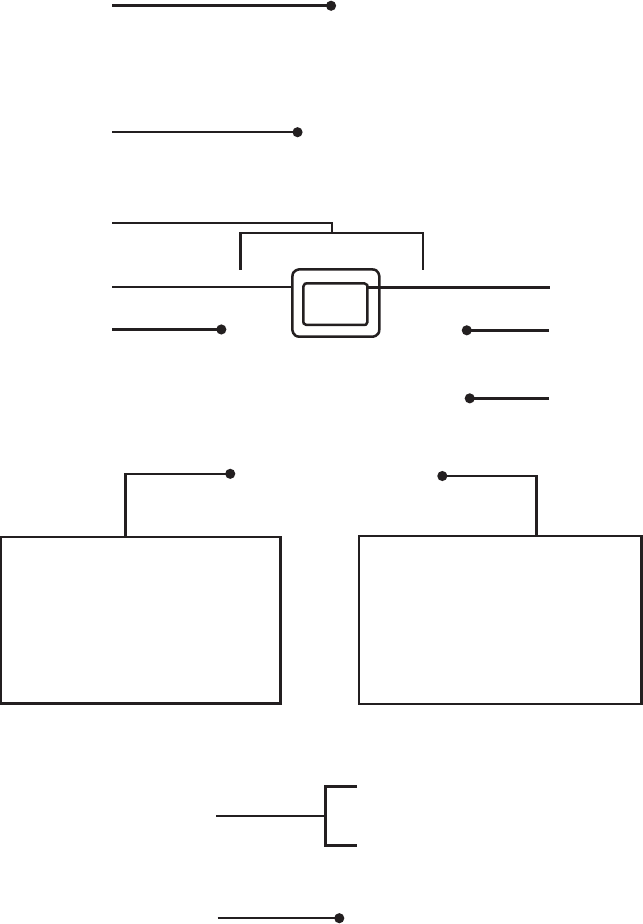
Your Phone
Phone Components
1
2
3
4
5
Press and hold
to access Voice
Recorder.
Press and hold to
activate/deactivate
Vibration Mode.
8
6
7
10
9

1. Earpiece: Lets you hear the
caller during a call.
2. Main LCD: Displays phone
status icons, menu items, web
items, web information, pictures
and more, in full color.
3. Left soft key/Right soft key:
Each of these keys perform the
functions indicated by the text on
the display immediately above
them.
4. Navigation keys
Standby Mode Hotkeys:
Contact List
New Message
Calendar
My StuffMy Stuff
- In a menu: Navigates between
menus.
5. Send key: Press this key in
standby mode to quickly access
the most recent missed, dialed,
and received calls.
6. OK key
7. End/Power key: Allows you to
power the phone on or off, end
calls, or return to standby mode.
8. Clear key: Allows you to return
to the previous screen. Press
and hold to activate the Voice
Command function.
9. Volume keys: Allows you
to control the Master Volume
while in standby mode and the
earpiece volume during a call.
10. Charger/USB port
Your Phone

Rear view
BATTERY COVER
EXTERNAL
CAMERA LENS
SIM CARD SLOT BATTERY
SD CARD SLOT

Installing the SIM
card and battery
1. Remove the battery cover
Use your right thumb to press
on the bottom center of the
battery cover, then slide the cover
upwards (as depicted below).
Then, lift the cover to remove it.
2. Remove the battery
Hold the top edge of the phone
and use the fingernail cutouts
near the bottom of the battery to
lift the battery from the phone.
Warning
Do not remove the battery when
the phone is turned on; this can
damage the phone.
3. Install the SIM card
Slide the SIM card into the SIM
card slot (as shown below). Make
sure that the gold contact area
on the card is facing downwards.
To remove the SIM card, pull it
gently in the opposite direction.
Getting Started

4. Install the battery
Insert the top of the battery first
into the top edge of the battery
compartment. Ensure that the
battery contacts align with the
terminals on the phone. Press the
bottom of the battery down until
it snaps into place.
Charging your phone
Unfasten the cover of the Charger/
USB port on the left side of your
phone. Insert the charger connector
to the phone (the ‘LG’ side of the
connector has to be facing up when
connecting to the phone) and then
plug into the wall socket. Your LG-
530G will need to be charged until
the Full Battery message appears
on the screen.
Important!
You must insert the battery
before charging.

Warning
Use of unauthorized accessories
could damage your phone and
void your warranty.
Installing a memory
card
You can expand the memory
available on your phone by using a
microSD™ memory card.
Tip
A memory card is an optional
accessory.
Locate the microSD card slot on
the right side of the phone. Then,
use your fingernail to gently lift
the cover.
The cover will remain attached
to the phone, so that it does not
become lost.
1
With the microSD card facing up,
slide it into the microSD card slot
(as demonstrated in the following
image).
Push the memory card in until it
locks into place.
Replace the slot cover on the
phone.
Note
If your memory card has existing
content, it will automatically
be filed in the correct folder.
For example, videos will be
accessible from the Videos folder.
2
3
Getting Started
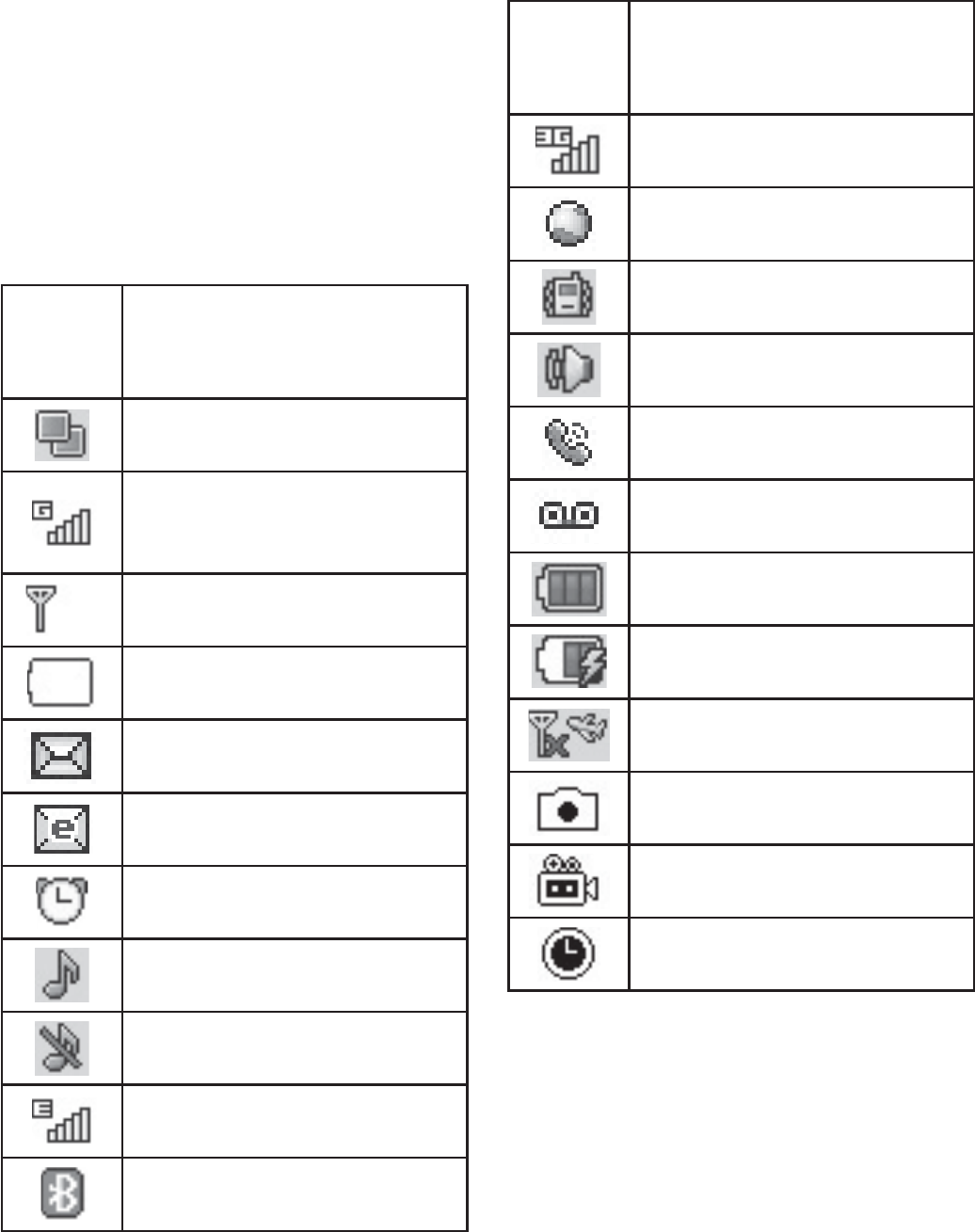
On-Screen Icons
The table below describes various
display indicators or icons that
appear on the phone’s display
screen.
ICON/
INDICATOR
DESCRIPTION
Multitasking
Network signal strength
(number of bars will vary)
No network signal
Low Battery
New text message
New email
An alarm is set
Ring profile in use
Silent All profile in use
EDGE network available
Bluetooth is active
ICON/
INDICATOR
DESCRIPTION
3G network available
The browser is active
Vibrating Mode On
Speakerphone
Call in Progress
Voicemail
Battery Full
Battery Charging
Flight Mode On
camera in use
camcorder is recording
camcorder timer

Making a Call
Make sure your phone is
powered on.
Enter a phone number including
the area code. To edit a number
on the display screen, simply
press the key to erase one
digit at a time.
►
Press and hold the key to
erase the entire number.
Press the [SEND] key
to call the number.
To end the call, press the
[END] key.
Making a Call with the
Send Key
Press the [SEND] key,
and the most recent missed,
dialed and received calls will be
displayed.
Highlight the desired number by
using the navigation keys.
1
2
3
4
1
2
Press the [SEND] key.
Making International
Calls
Press and hold the key and
the international access character
‘+’ will appear.
Enter the country code, area
code, and the phone number.
Press the [SEND] key
to call the number.
Ending a Call
To end a call, press the
[END] key.
Making a Call from the
Contacts
You can store frequently called
names and phone numbers in the
SIM card as well as in the phone
memory known as the Contacts.
You can dial a number by simply
highlighting a name in the Contacts
3
1
2
3
General Functions

List and pressing the
[SEND] key.
Press the [Down] key to
access the Contact List.
Highlight the Contact and press
the [SEND] key.
Answering a Call
When you receive a call, the phone
displays a notification on the screen
and rings and/or vibrates. If the
caller can be identified, the caller’s
phone number (or name, if stored in
your Address Book) is displayed.
Press the [SEND] key
or the left soft key
Accept to answer an incoming
call.
If the Answer Mode has been set
as Any Key ( Menu
> Settings > Call >
Answer Mode), any key
press will answer a call, except
for the [END] key, the
1
2
1
right soft key , or the
volume keys .
End the call by pressing the
[END] key.
Note
You can answer a call while using
other functions or features.
2

Adjusting the Volume
Use the side volume keys during a
call to adjust the earpiece volume.
While in standby mode, you can
adjust the Master Volume using the
side volume keys.
Vibrating Mode (Quick)
Vibrating Mode can be activated
by pressing and holding down the
key.
Signal Strength
If you are inside a building, being
near a window may give you better
reception. You can see the strength
of your signal by the signal indicator
on your phone’s display screen.
Entering Text
You can enter alphanumeric
characters by using the phone’s
keypad. For example, storing names
in the Address Book, writing a
message, or scheduling events in
the calendar all require text to be
entered.
Changing the Text Input
Mode
Change the text input mode by
holding down when in a text
entry field.
You can check the current text input
mode in the upper right corner of
the screen.
The following text input modes are
available on the phone.
ABC Mode
This mode allows you to enter
letters by pressing the key labeled
with the required letter one, two,
General Functions

three, or four times until the letter
is displayed.
123 Mode (Numbers
Mode)
Type numbers using one keystroke
per number. To change to 123
mode in a text entry field, press the
key until 123 mode is displayed
in the upper right corner.
Symbol Mode
The Symbol Mode enables you to
enter various symbols or special
characters. To enter a symbol, press
the key. Use the navigation keys
to highlight the desired symbol and
press the key.
Using the ABC Mode
Use the alphanumeric keypad to
enter your text.
Press the key labeled with the
required letter:
►
Once for the first letter.
►
Twice for the second letter.
►
And so on.
To insert a space, press the
key once. To delete letters, press
the
key. Press and hold down
the
key to erase all of the
entered text.
1
2

Note
Refer to the table below for more
information on the characters
available using the keys.
Key Characters in the Order Displayed
Upper Case Lower Case
1. , ’ @ ? !
- : / 1 . , ’ @ ? ! - : / 1
2 A B C 2 a b c 2
3 D E F 3 d e f 3
4 G H I 4 g h i 4
5 J K L 5 j k l 5
6 M N O 6 m n o 6
7 P Q R S 7 p q r s 7
8 T U V 8 t u v 8
9 W X Y Z 9 w x y z 9
0Space Key,
0 (Long press)
Space Key,
0 (Long press)
Using the 123 (Numbers)
Mode
The 123 Mode enables you to
enter numbers in a text message
(a telephone number, for example)
more quickly. Press the keys
corresponding to the required digits
before manually switching back to
the appropriate text entry mode.
General Functions

During a Call
Your phone provides a number
of control functions that you can
use during a call. To access these
functions during a call, press the
left soft key Options.
Making a Second Call
You can select a number you wish
to dial from the Address Book to
make a second call.
Press the left soft key
Options, then select Address
Book.
Highlight the contact, then press
the [SEND] key to
make a second call.
Swapping Between Two
Calls
Once the second call has been
dialed (or answered), you can switch
between the calls by using one of
the following three methods:
1
2
►
Press the [SEND] key.
►
Press the left soft key
Options and then select “Swap
Calls”.
►
Press Up/Down on the navigation
key.
Answering an Incoming
Call
To answer an incoming call when
the handset is ringing, simply press
the [SEND] key. The
handset is also able to warn you
of an incoming call while you are
already on a call. A tone sounds
in the earpiece and the display
will show that a second call is
waiting. This feature, known as Call
Waiting, is only available if your
network supports it.
If Call Waiting is turned on, you can
put the first call on hold and answer
the second call by pressing the
[SEND] key.
In-Call Menu
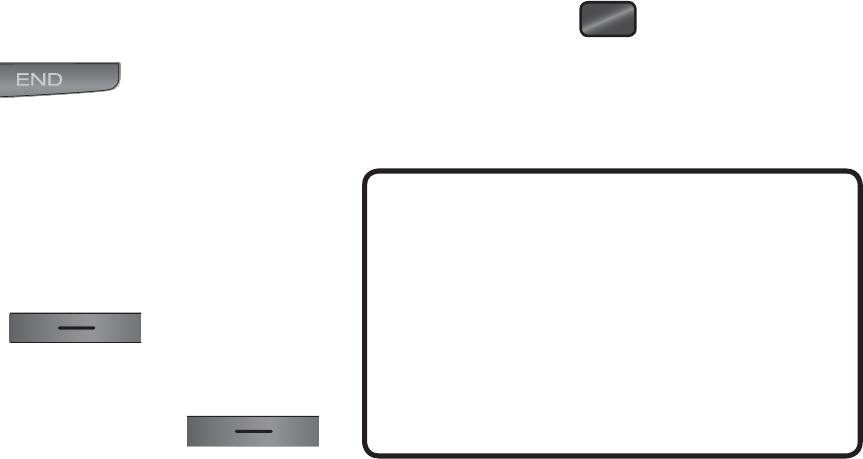
Rejecting an Incoming
Call
You can reject an incoming call
without answering by simply
pressing the [END] key.
Muting the Microphone
You can mute the microphone
during a call by pressing the
right soft key Mute.
The handset can be unmuted by
pressing the right soft key
Unmute. When the handset is
muted, the caller cannot hear you,
but you can still hear the caller.
Using the Speakerphone
You can use the integrated
Speakerphone during a call
by pressing the key.
The loudspeaker is automatically
deactivated when you end the call.
Warning
Due to increased volume levels,
do not place the phone near your
ear while the speakerphone is
enabled.
In-Call Menu

Conference Calls
The conference call feature
provides you with the ability to
have a simultaneous conversation
with more than one caller. The
conference call feature can be used
only if your network service provider
supports this feature.
Once a conference call is set up,
calls may be added, disconnected
(Exclude Call option allows you
to select a call to disconnect from
the conference call), or separated
(Private Call option allows you to
separate a call from the conference
call, but still connected to you)
by the person who set up the
conference call. These options are
all available from the In-Call menu.
The maximum number of callers
in a conference call is five. Once
started, you are in control of the
conference call, and only you can
add calls to the conference call.
Making a Second Call
You can make a second call
while currently on a call simply
by entering the second number
with the keypad and pressing the
[SEND] key. When the
second call is connected, the first
call is automatically placed on hold.
You can swap between calls by
pressing the [SEND] key.

Setting Up a Conference
Call
To set up a conference call,
place the first call. Once that is
connected, follow the steps above
to make a second call. You can
then join the two separate calls by
pressing the left soft key
Options, selecting Conference
Call, and then Join Calls.
Place the Conference Call
on Hold
To place a conference call on hold,
press the [SEND] key.
Adding Calls to the
Conference Call
To add a call to an existing
conference call, press the left
soft key Options, select
Conference Call, and then select
Join Calls.
Private Call in a
Conference Call
To have a private call with one of
the callers in the conference call,
press the left soft key
Options, select Conference Call,
and then Private Call. When
the numbers of the callers are
displayed, select the one with which
you wish to speak in private.
Ending a Conference Call
An active conference call can
be disconnected by pressing the
[END] key.
In-Call Menu
1. Prepaid
1.1 Add Airtime
1.2 Buy Airtime
1.3 My Phone Number
1.4 My Airtime Info
1.5 Airtime Display
1.6 Serial Number
1.7 SIM Number
1.8 Code Entry Mode
2. Contacts
2.1 Contact List
2.2 New Contact
2.3 Groups
2.4 Speed Dial
2.5 SIM Management
2.6 Own Number
2.6 My Business Card
3. Messages
3.1 Create Message
3.2 Inbox
3.3 Drafts
3.4 Outbox
3.5 Message Settings
4. Recent Calls
4.1 All Calls
4.2 Missed Calls
4.3 Dialed Calls
4.4 Received Calls
5. Games & Apps
6. E-mail
7. Music
7.1 Now Playing
7.2 All Songs
7.3 Playlists
7.4 Artists
7.5 Albums
7.6 Genres
7.7 Shuffle Songs
Menu Tree
8. Camera
8.1 Take Photo
8.2 Record Video
8.3 Camera Album
9. My Folder
9.1 Audio
9.2 Pictures
9.3 Video
9.4 Other Files
9.5 File Manager
10. Tools
10.1 Alarm Clock
10.2 Calendar
10.3 Notepad
10.4 Calculator
10.5 Tasks
10.6 Stopwatch
10.7 Tip Calculator
10.8 Unit Converter
10.9 Voice Recorder
11. Browser
12. Settings
12.1 Audio & Ringtones
12.1.1 Ringtone
12.1.2 Message Tone
12.1.3 Alert Tone
12.1.4 Keypad Tones
12.1.5 Multimedia
12.1.6 Call
12.2 Phone Settings
12.2.1 Languages
12.2.2 Set Hotkeys
12.2.3 Auto Key Lock
12.2.4 Flight Mode
12.2.5 Security
12.2.6 Reset Settings
12.3 Display
12.3.1 Wallpapers
12.3.2 Fonts
12.3.3 Clocks & Calender
12.3.4 Brightness
12.3.5 Backlight Timer
Menu Tree
12.3.6 Color Schemes
12.3.7 Menu Styles
12.4 Call
12.4.1 Send My Number
12.4.2 Answer Mode
12.4.3 Time & Cost
12.4.4 Accessability
12.5 Bluetooth
12.5.1 Turn On(Turn off)
12.5.2 Search New Device
12.5.3 My Devices
12.5.4 My Bluetooth Info
12.6 Memory
12.6.1 Used Space
12.6.2 Set Storage Defaults
12.7 Application
12.7.1 Messages
12.7.2 Browser
12.8 Phone Information

This manu allows you to check the
prepaid related contents.
To access Prepaid, from the standby
screen, press the left soft key
Menu and Prepaid.
You can access the Menu below.
Add Airtime – Recharge the fee
using the Airtime PIN code.
Buy Airtime – Recharge the fee
by selecting from the calling plan.
My Phone Number – Shows your
phone number.
Airtime Info – Shows you the
Airtime info. Based on different
brand such as Balance, Due
Date, and Service End Date etc.
Airtime Display – Set On/Off for
displaying Balance / Due Date on
Idle screen.
Serial Number – Shows you the
Serial Number.
SIM Number – Shows you the
SIM Number.
1
2
3
4
5
6
7
Code Entry Mode – Allows you
to insert the device code for
Tracfone’s PPE setting or info.
8
Prepaid
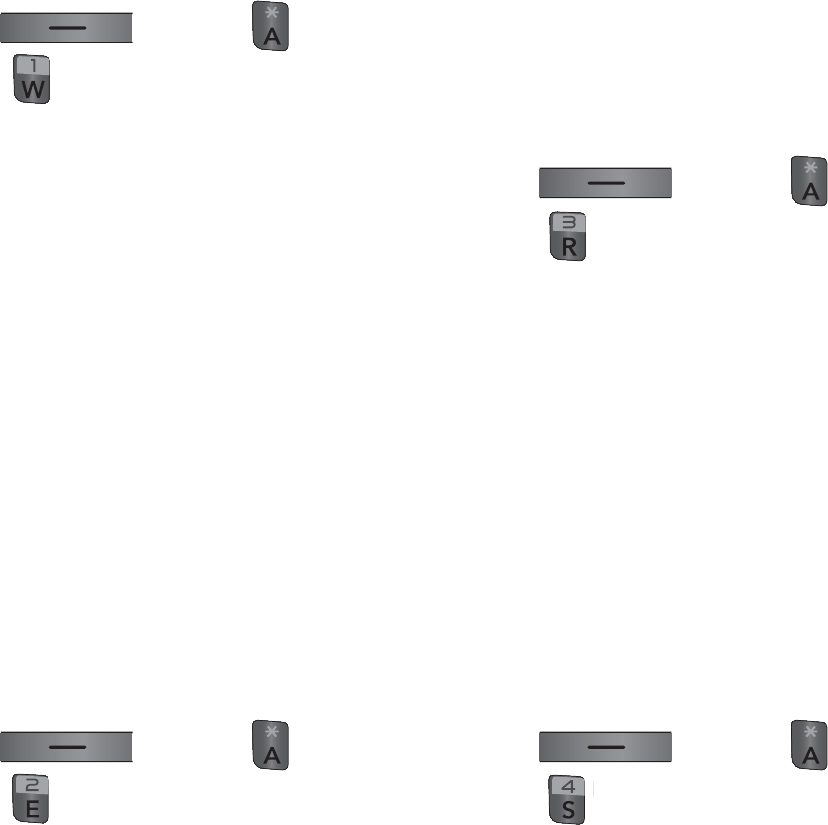
Contact List
This menu allows you to save
and manage contact address
information. The Conta ct List’s
functions allow you to add a new
address or search saved contact
addresses by name.
To access Contact List, from the
standby screen, press the left soft
key Menu, Contacts
and Contact List.
New Contact
This menu allows you to add a new
contact to the Contact List. You can
enter contact address information
including name, phone numbers,
email addresses, group information
items, memos, ring tones, and a
contact Picture ID.
To access New Contact, from the
standby screen, press the left soft
key Menu, Contacts
and New Contact.
Caller Groups
This menu allows you to manage
group information. You can also
configure a ring tone for a group
so that the group ring tone sounds
when a call from a specific contact
address within that group is
received and there is no ring tone
configured for the specific contact
address.
To access Caller Groups, from the
standby screen, press the left soft
key Menu, Contacts
and Caller Groups.
Speed Dial
This menu allows you to assign
a frequently-called contact to the
Speed Dial List. You can select a
number from 2 to 9 as a speed dial.
To access Speed Dial List, from the
standby screen, press the left soft
key Menu, Contacts
and Speed Dial.
Contacts
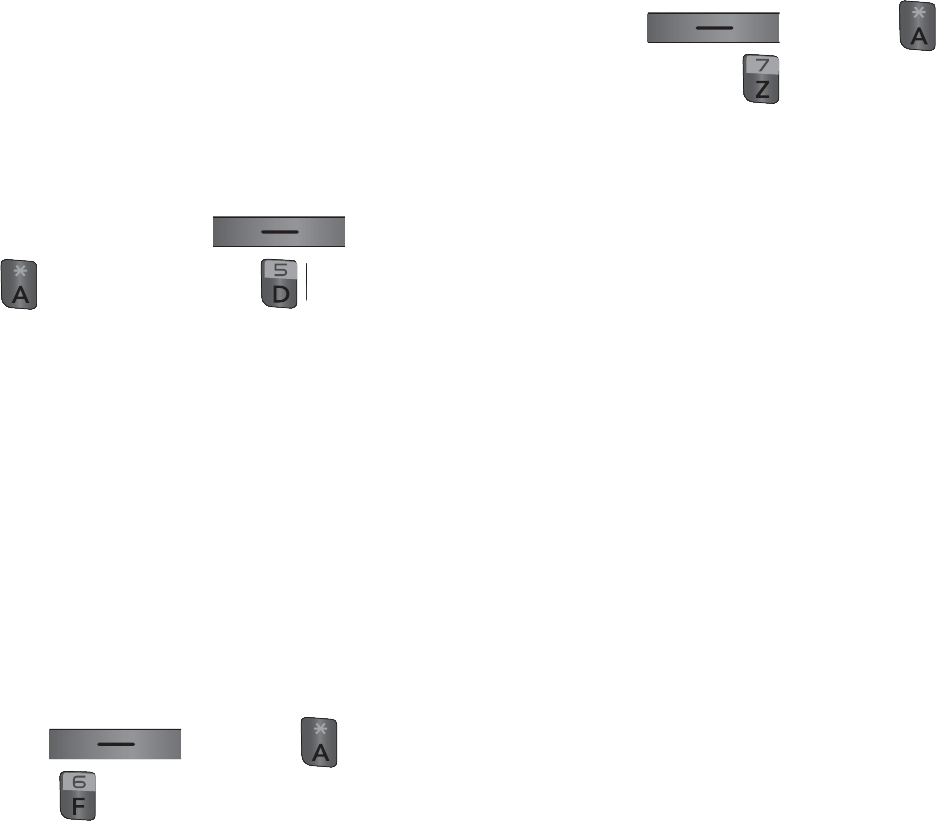
SIM Management
This menu allows you to copy
information from your SIM card
to your handset and vice versa. If
a name is duplicated during the
copying operation, the information is
also duplicated. You can also delete
information from the SIM card.
To access SIM Management,
from the standby screen, press
the left soft key Menu,
Contacts and SIM
Management.
Own number
This displays your phone numbers
stored in the SIM card.
To access Own number, from the
standby screen, press the left soft
key Menu, Contacts
and Own Number.
My business card
This display your business card
stored in the handset. You can also
delete or edit.
To access My business card, from
the standby screen, press the left
soft key Menu,
Contacts and My business
card.
Contacts
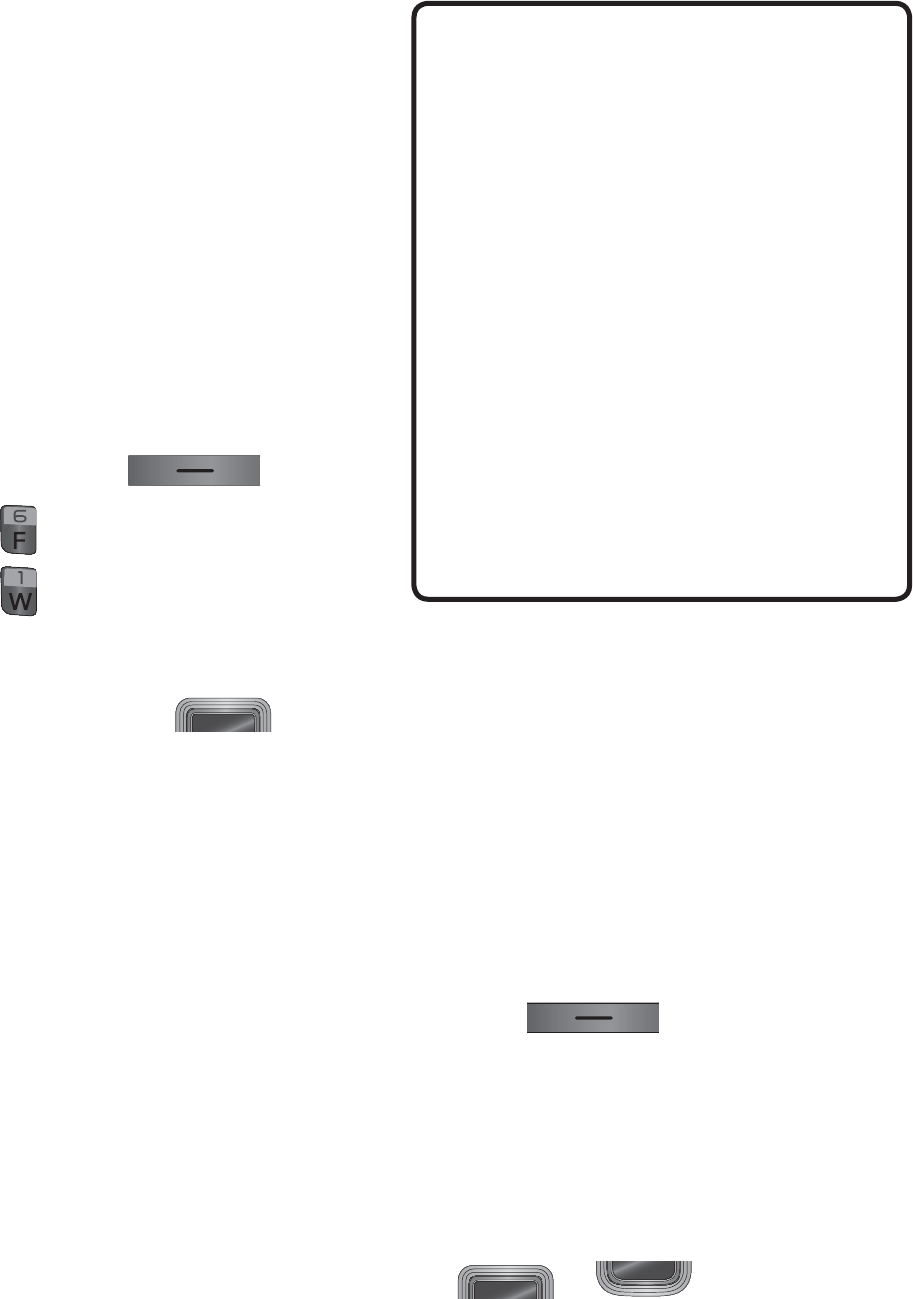
This menu includes functions
related to SMS (Short Message
Service), MMS (Multimedia Message
Service), Voicemail as well as the
network’s service messages.
Create Message
From the standby screen, press
the left soft key Menu.
Press Messages.
Press Create Message.
OR
You can simply press [Up]
from the standby screen.
1
2
3
Note
If you insert a Picture, Audio,
or Video file while writing a
multimedia message, the file
loading time will take about
5 seconds. You will not be able
to activate any key during the
file loading time. When the file
loading is complete, you will
be able to write a multimedia
message.
Editing a message
The following options are available
when editing a message.
Using Insert
While entering text, press the left
soft key Options. In this
menu, you can choose Insert.
►
Symbol: You can insert various
symbols into your message.
Pressing the Up and Down keys
/ scrolls through
the pages.
Messages

►
Picture: You can select a picture
to insert by using the navigation
keys. You can preview the
selected picture by pressing the
left soft key View.
►
Audio: You can insert an audio
file from your saved audio files.
►
Video: You can insert a video
clip from your saved video clips.
►
Take New Picture: you can
take and insert a picture in your
message.
►
Record New Audio: You can
record a new audio clip by
pressing Record. Press the
right soft key Options
before you begin recording to
set the options (below). After
recording a new audio clip, you
can delete it by pressing the
right key Delete.
• Quality: Set the audio’s quality
to Fine, Normal, or Economy.
• Select Storage Defaults:
You can assign the default
storage to Phone Memory or
Memory Card.
►
Record New Video: You can
record a new video by pressing
Record. When finished
recording, press Insert.
►
Template
• Text: Allows you to easily insert
frequently used sentences in
the text message.
• Multimedia: Preset
multimedia templates can be
created ( Menu
> Messages >
Message Settings >
Multimedia Message >
Multimedia Templates >
New).
Messages
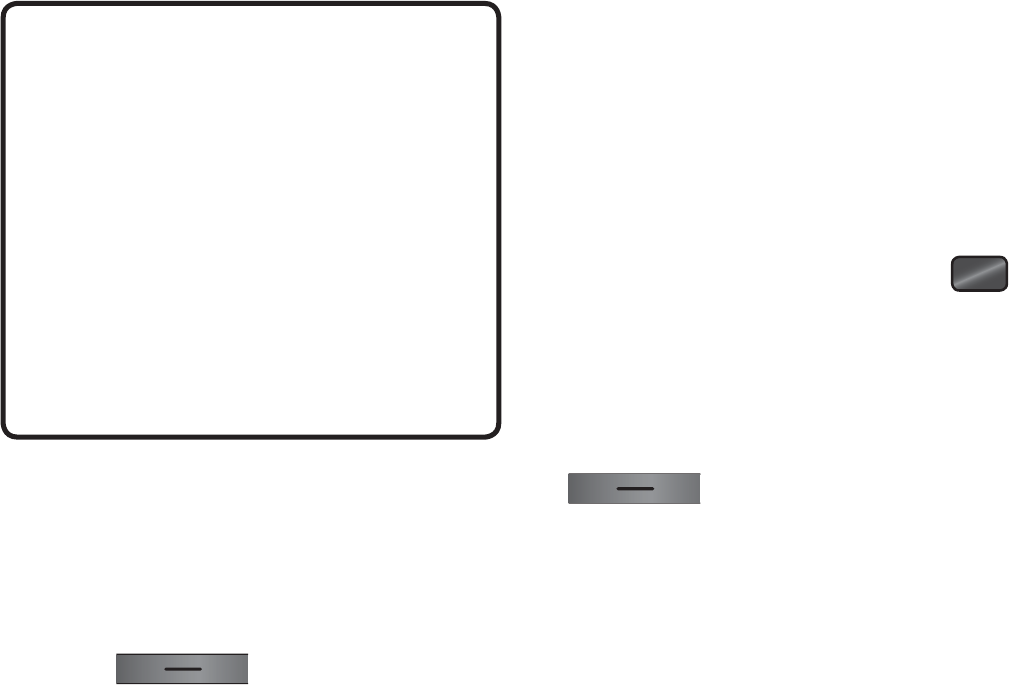
• Signature: Allows you to insert
your own created signature.
For further details.
►
More: Allows you to insert
vCard, vCalendar, vNote, vTask
or Contact.
Note
vCard, vCalendar, vNote and
vTask are created by the Address
Book, Calendar, Notepad, and
Tasks functions, respectively. Go
to the Tools and Address Book
sections in this Manual for more
detailed information.
Using Options
While entering text, press the right
soft key Options.
Insert allows you to insert Symbol,
Picture, Audio, Video, template
or more. You can also take new
picture or record new audio/video
to insert.
Writing language allows you
to set the text entry language to
English, Spanish.
• Save to Drafts: Saves the
message to Drafts.
• Cancel Message: Allows you to
exit the text input mode without
saving your message.
Sending a Message
After completing a message, using
Insert and/or Options, press
Send To to select a recipient.
• Enter the recipient(s). For more
options, press the left soft key
Options. In this
menu, you can choose from the
following options:
- Enter Number: Allows you to
enter the phone number using
the keypad.
- Enter Email: Allows you to
enter an email address instead
of a phone number.
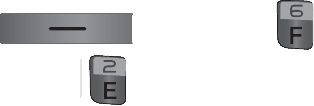
- Insert Symbol: Allows you to
enter symbols.
- Caller Groups: Displays
Contacts Groups.
- Recent Messages: Choose a
Contact from Recent Messages.
- Recent Calls: Choose a
Contact from Recent Calls.
- Delivery Options: Allows you
to set the options for Add Cc,
and Add Bcc.
- Edit Message: Go back to the
message editing mode.
- Save to Draft: Saves the
selected message to Drafts.
- Writing language: allows you
to set the text entry language to
English, Spanish.
- Cancel Message: Allows you
to cancel the message.
Inbox
You will be alerted when you receive
a message. New messages are
stored in the Inbox. In the Inbox, you
can identify each message by icons.
If you are notified that you have
received a multimedia message, you
can download the whole multimedia
message by selecting it in the Inbox
menu. To reach the Inbox, from
the standby screen, press the left
soft key Menu >
Messages > Inbox.
►
Add to Address Book: You can
save the sender’s phone number
in the Contact List.
►
Delete: You can delete the
selected message.
►
Forward: You can forward the
selected message to another
person.
Messages
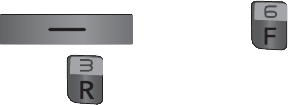
►
Copy to Phone/Copy to SIM:
You can copy to Phone or SIM
depending on where the text
message is stored.
►
Select Multiple: You can select
multiple messages.
►
Message Details: You can view
the following information about
received messages: message
Type, Subject, From, and
message Time.
►
Delete All Read Messages:
You can delete all read
messages.
Drafts
Allows you to view and edit the
messages saved as drafts. To
access drafts, from the standby
screen, press the left soft key
Menu, Messages,
and Drafts. The following
options are available for the Drafts
folder:
►
Select Multiple: Allows you
to select multiple messages to
delete.
►
Message Details: Allows you to
view the details of the message.

Outbox
Outbox is the storage place for
recently sent messages. When you
press the [SEND] key, you
can call the recipient of the selected
message.
If the message is not sent from the
Outbox, you will receive a sound
alert along with a Message Sending
Failure notice on the screen.
Another attempt will be made to
send the failed message and after
two unsuccessful attempts, the
message will no longer be sent
automatically. In order to send the
message that has failed, you must
press the left soft key
Resend to resend the message.
To access the Outbox, from the
standby screen, press the left
soft key Menu,
Messages, and Outbox.
The following options are available
for the Outbox folder:
►
View Status: Shows the status
of each message.
►
Delete: Deletes the selected
message.
►
Edit: Allows you to edit the
selected message.
►
Select Multiple: Allows you
to select multiple messages to
delete.
►
Message Details: Allows you to
view the details of the message.
Messages
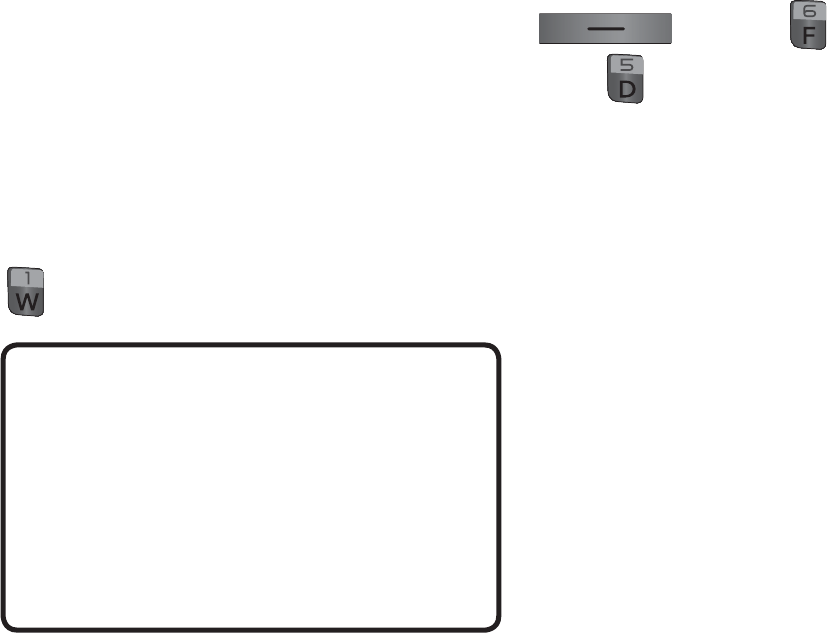
Voicemail
This menu provides you with
a quick way of accessing your
voice mailbox (if provided by your
network).
A shortcut for checking your
voicemail is available. To quickly
check your voicemail when in
standby mode, press and hold the
key.
Note
Please check with your network
service provider for details of
their service in order to configure
the handset accordingly.
Message Settings
To access and configure your
Message Settings, from the standby
screen, press the left soft key
Menu, Messages,
and Message Settings.
Message Alert
Allows you to set the Sounds,
Volume, and Alert Type.
Save To
Allows you to choose whether to
save to the SIM Card or the Phone.
Signature
Allows you to create, edit, and
delete your signature, which can be
configured to be sent out with your
outgoing messages.
Text Message
Allows you to set preferences for
text messages.

The following options are available:
►
Text Templates: Predefined
messages that can quickly be
sent. Press the right soft key
Options to access the
following available options:
• Send: Allows you to send the
selected template via Message.
• Delete: Allows you to
delete the selected template
message.
• Edit: Allows you to edit the
selected template message.
• Delete All: Deletes all
messages in the folder.
►
Message Center Number:
Allows you to view and edit the
phone number for the Message
Center. Do not edit unless
instructed to do so by your
service provider.
►
Email Gateway: Allows you to
view and edit the Email Gateway.
Do not edit unless instructed to
do so by your service provider.
►
Insert Signature: Allows you to
insert your signature in outgoing
messages.
Multimedia Message
Allows you to set your preferences
for multimedia messages.
The following options are available:
►
Multimedia Templates: Allows
you to add, edit, and delete
multimedia templates. Press the
left soft key Options
to access the following available
options:
• Send: Allows you to send
the selected message via
Multimedia Message.
• Delete: Allows you to delete
the selected template
message.
• Edit: Allows you to edit the
selected template message.
Messages
• Rename: Allows you to
rename the selected template
message.
• Delete All: Allows you to
delete all the messages at one
time.
Voicemail Number
This menu allows you to set the
Voicemail Center Number if this
feature is supported by . Please
check with for details of their
service in order to configure the
handset correctly.
Service Message
Allows you to configure your
settings to determine if you would
like to receive service messages.

This menu allows you to see the list
of recently received calls. To access
Recent Calls, from the standby
screen, press the left soft key
Menu, and Recent
Calls.
You can access the list of All Calls/
Missed Calls/ Dialed Calls and
Received Calls.
Recent Calls

This menu allows you to download
or access the various games and
applications.
To access the Games & Apps, from
the standby screen, press the left
soft key Menu, and
Games & Apps.
Games & Apps
Sending an email using
your new account
To send/receive an email, you
should set up an email account.
Press Menu, select E-Mail and
choose the account you want
to use.
From Options choose Write e-
mail and a new email window
will open.
Enter address in To field then
Write a subject line and press
down navigation key.
Enter your message using the
keypad then Press Ok to send
the email.
Retrieving your email
Press Menu and select E-mail.
Select the account you want
to use.
Select Inbox.
Choose Refresh and the phone
will connect to your email
account and retrieve your new
1
2
3
4
1
2
3
4
Message folders
Press Menu and select E-mail. The
folder structure used on your LG-
530G should be self-explanatory.
Write e-mail - Create your new
message.
Mailboxes
Inbox - All the e-mails you receive
are placed into your Inbox. From
here you can reply, forward and
more.
Drafts - If you don’t have time
to finish writing a e-mail, you can
save what you have written so far
in here.
Outbox - This is a temporary
storage folder while e-mail are
being sent or stores the messages
that are failed to sent.
Sent - Copies of all the e-mail you
send are kept into your Sent folder.
Phone Trash - All the e-mail you
remove are placed into your Phone
Trash.
E-Mail
Changing your email
settings
Press Menu, choose E-mail
> Options > Mailboxes >
Accounts.
Select the account you want
to use.
Select Options then settings from
options then you can adapt the
following settings:
Accounts - You can edit e-mail
account settings.
Schedule - Choose the time period
during when the Push Email will
be active.
Notification - Choose whether or
not to be alerted to new emails.
Default Account - Choose which
account to compose e-mail by
default.
Signature - Create an email
signature and switch this feature on.
1
2
3
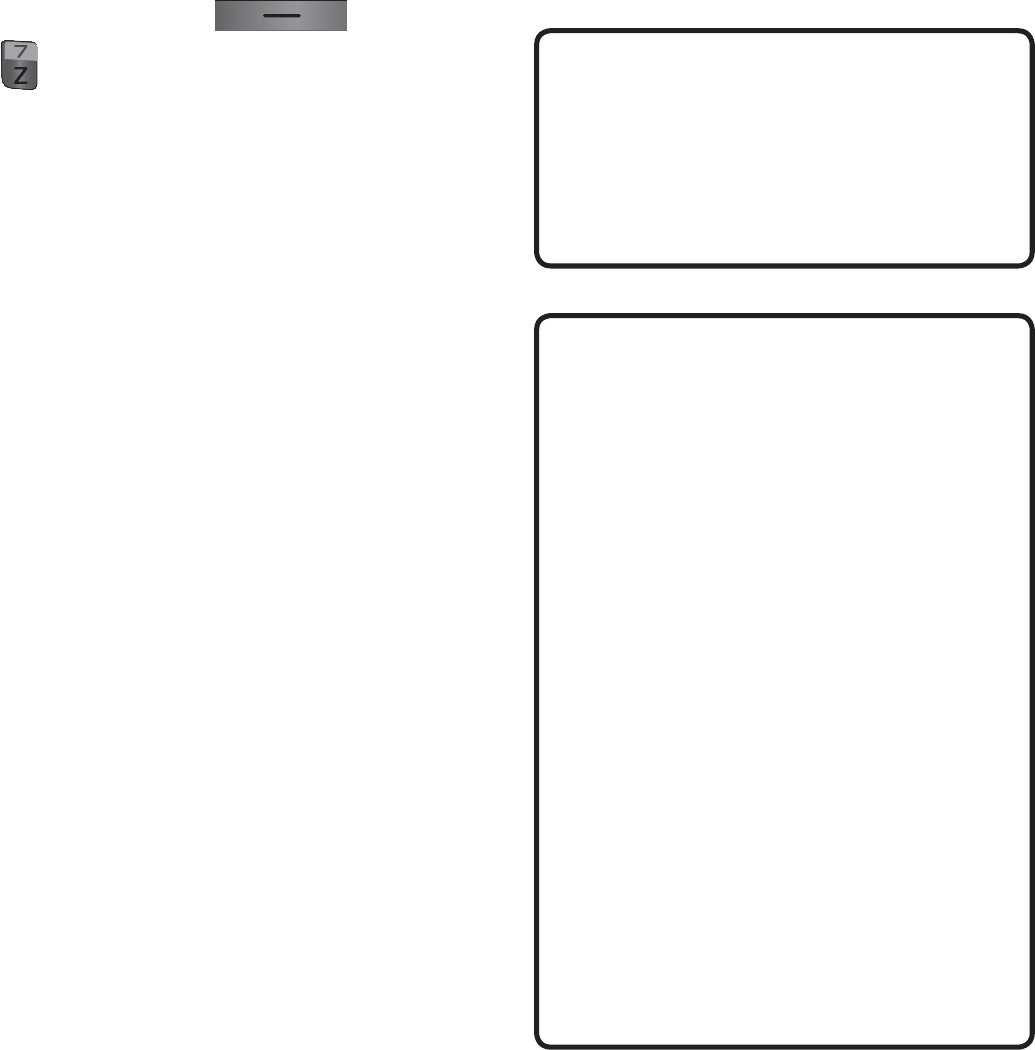
Music
You can access Music by pressing
the left soft key Menu,
Music.
Music Player
►
All Songs: Allows you to view all
the songs in your music library.
►
Playlists: Allows you to create
your own playlists.
►
Artists: Shows the list of artists
of all the songs in your music
library, and shows all the songs
by a chosen artist.
►
Albums: Shows the list of
albums of all the songs in your
music library, and shows all the
songs on a chosen album.
►
Genres: Shows the list of genres
of all the songs in your music
library, and shows all songs of a
specific genre.
►
Shuffle Songs: Allows you to
play all the songs in your music
library in random order.
Tip!
The music player plays formats
such as MP3, AAC, AAC+, and
WMA.
Note
Copyrights of music files may
be protected by copyright
and intellectual property laws.
Please ensure that you adhere
to the applicable Terms of
Use of materials laws prior to
downloading or copying files.
To play songs from or transfer
songs to SD card, the SD card
should have some empty space.
Up to 512MB card: Require
3MB empty space
Music
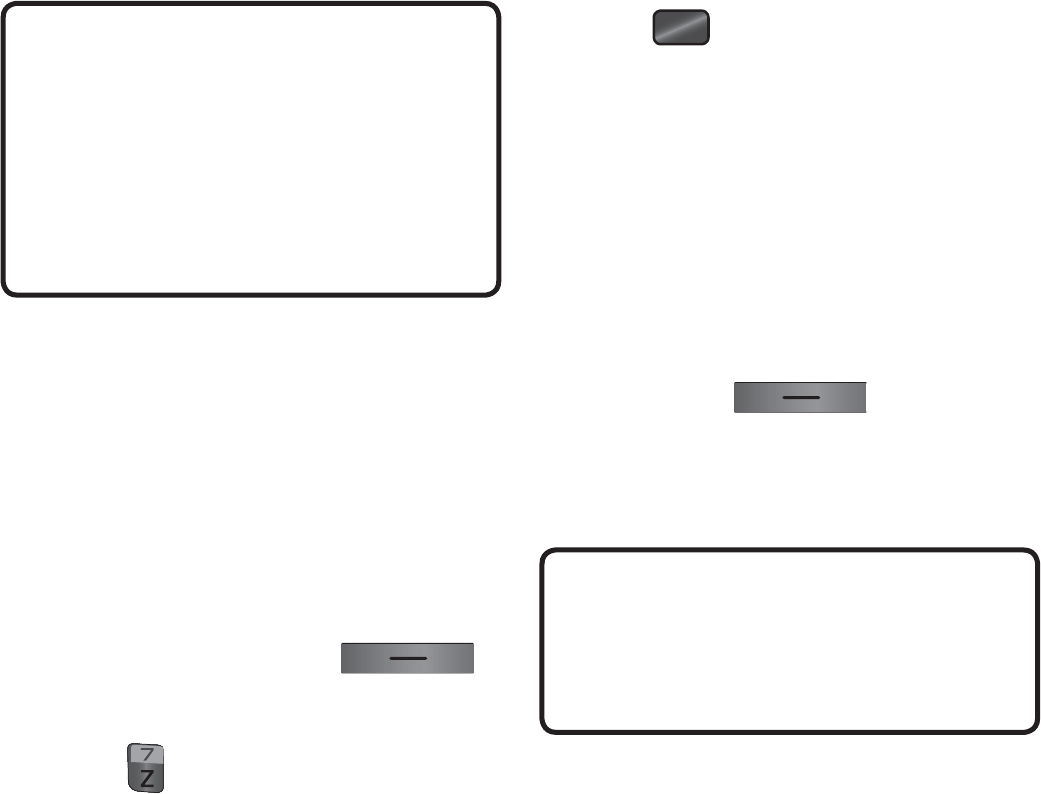
Up to 4GB card: Require 6MB
empty space
Up to 16GB card: Require
20MB empty space (Up to 1000
songs)
Playing Music
To listen to music that you have
transferred to your phone, follow
these quick easy steps:
Press the left soft key
Menu to open the Main Menu.
Press Music Player to view
your options. You can select from
Now Playing, All Songs, Playlists,
Artists, Albums and Genres to
select your Music or you can just
select Shuffle Songs to shuffle
your collection.
1
2
• Press to Play/Pause a
selected song. While playing,
press the up or down navigation
keys to change the volume and
the left or right navigation keys to
go to the previous or next song.
• While playing music, press the
left soft key Option
to access other phone functions
while music is playing.
Note
Files under 300kb are stored as
ringtone files.

Adding Music To Your
Handset
Music files can be added to your
handset by using one or more of
the following methods:
• Download music and ringtones
over the network directly to your
device.
• From your PC using other music
subscription services, such as
Napster or eMusic.
Note
Some sites are data intensive
(i.e. previews via streaming) so
the user should be enrolled in an
unlimited data plan before using
these services to avoid per-use
data charges.
Additional charges may apply
when downloading music,
ringtones etc.
Transferring Music using
your PC
Before You Get Started
To transfer music from your PC
to your device, you will need the
following:
• Music on your PC in one of these
formats:
MP3, .AAC, AAC+ or WMA ,aac,i
my,mid,midi,mmf,mp3,3ga,wav,m
4a, wma,amr (except ringtone)
• A MicroSD™ card*
(supports up to 16GB cards)
• USB data cable*
* MicroSD™ card and USB data
cable sold separately; go to att.
com/wireless for details.
Note
This device is not compatible with
iTunes and/or iTunes files.
Music

Drag and Drop Music Using
LG-530G As A Mass Storage
Device
Insert a microSD™ memory card
into the phone and make sure it
is powered on.
Connect the device to a PC using
a LG-530G USB data cable.
Access My Computer on the PC.
Locate the phone and double-
click it to open.
Note
The PC will automatically assign
a drive letter.
Browse the files in a new window
for desired music files.
Drag and drop the desired music
content from the PC window to
the “Storage Card” window.
Disconnect the device from the
cable.
Access the Music Player on the
phone.
1
2
3
4
5
6
7
8
Additional Music
Services
There may be other music
applications preloaded or available
for your phone that allow you to:
• Identify the name, artist, and
album to a song from a song
sample.
• Listen to the latest Classic, jazz,
pop, rock anywhere you go.
• View the latest music videos.
• View music news and information.
• Cut custom-made ringtones from
the favorite parts of your favorite
songs, etc.

Note
Some sites are data intensive
(i.e. previews via streaming) so
the user should be enrolled in an
unlimited data plan before using
these services to avoid per-use
data charges.
Additional charges may apply for
downloading content or use of
these services.
Music

To access Camera & Recordings,
from the standby screen, press the
left soft key Menu, and
Camera.
Take Photo
Using the camera module built into
your phone, you can take pictures
of people or events while on the
move. Additionally, you can send
photos to other people in a picture
message.
The following options will appear (as
icons) at the bottom of the screen.
►
Album: Allows you to see saved
image and video files.
►
Video: Allows you to switch to
Camcorder mode.
►
Capture: Allows you to capture
the image.
►
Zoom: Allows you to set the
zoom level.
►
Brightness : Allows you to set
the Brightness.
The right soft key
Settings will bring up the following
options:
Preview Tab
►
Image Size: The resolution of
the image can be captured in
1280*960, 640*480, 320*240.
►
Color Effects: Allows you to
choose from Color, Mono, Sepia,
or Negative.
►
White Balance: Set the White
Balance as Auto, Daylight,
Cloudy, Illuminate, or Indoors.
►
Night Mode: On/Off
►
Timer: Timer can be set to Off,
3 Seconds, 5 Seconds, or 10
Seconds.
►
Shot Mode
- Normal Mode: This set as
normal camera mode.
- Continuous Shot: This is great
for taking photos of moving
objects or at sporting events.
Camera
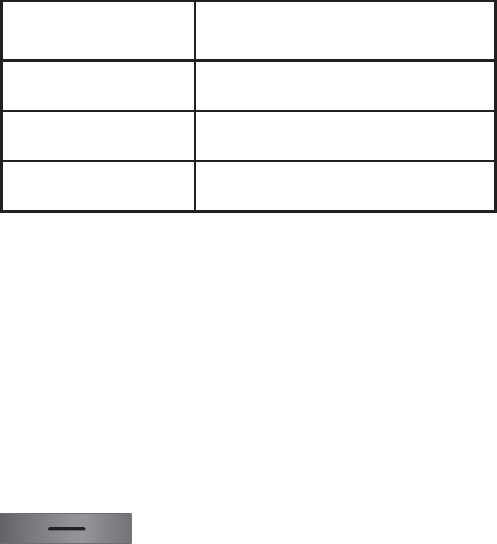
The continuous shot is only
available in QVGA(320x240)
mode and can be set to Off or
3/6/9 shots per event.
►
Image Quality: The quality of
the captured image can be set to
Super Fine, Fine, or Normal.
Others Tab
►
Shutter Tones: You can choose
from Tone 1, Tone 2, Tone 3,
or Off.
►
Reset Settings: Allows you to
set the Camera to the default
settings.
Using Zoom
In Take Photo mode, you can Zoom
in/out by using the up/down side
volume keys. The maximum zoom
scale depends on the resolution as
follows.
Resolution Zoom scale
1280*690 Not Available
640*480 Level 1 ~ Level 10
320*240 Level 1 ~ Level 10
Record Video
Allows you to record a video clip
with your phone. Before starting
to record, press the right soft key
Settings to configure
your settings.
The following options will appear (as
icons) at the bottom of the screen.
►
Album: Allows you to see saved
image and video files.
►
Photo: Allows you to switch to
the Camera function so you to
take a picture.
►
Record: Allows you to begin
recording the video.
►
Zoom: Allows you to set the
zoom level.
Camera
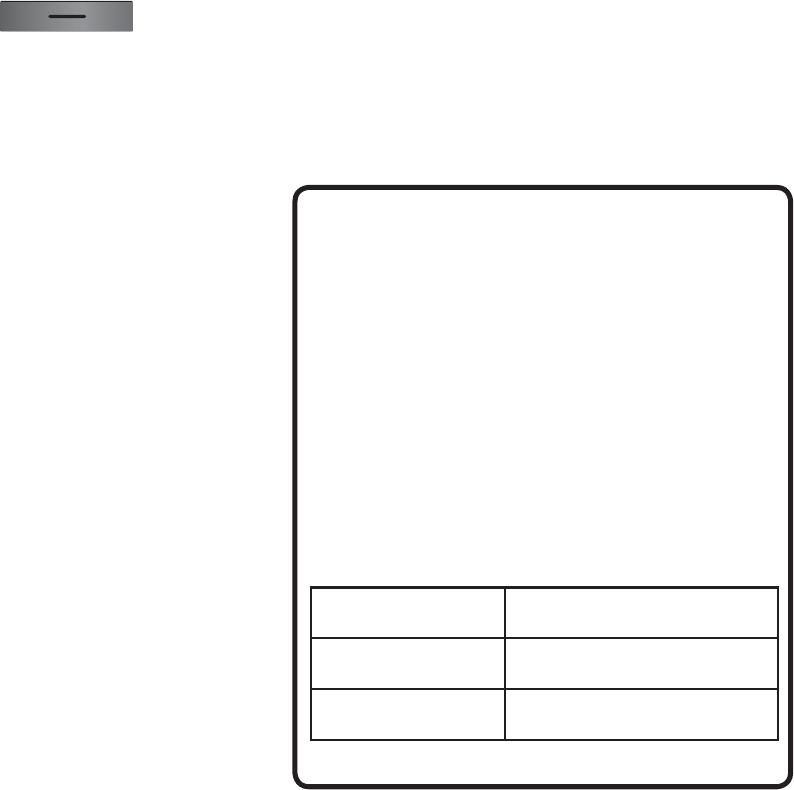
►
Brightness : Allows you to set
the Brightness.
The right soft key
Settings will bring up the following
options:
Preview Tab
►
Video Size: Allows you to select
a vide size between 320*240 or
176*144.
►
Color Effects: Allows you to
choose from Color, Mono, Sepia,
or Negative.
►
White Balance: Set the White
Balance as Auto, Daylight,
Cloudy, Illuminate, or Indoors.
►
Video Quality: Allows you to set
video quality to Super Fine, Fine,
or Normal.
►
Duration: Set the recording
duration to General Mode or
MMS Video mode.
Others Tab
►
Recording Tones: On/Off
►
Reset Settings: Allows you to
set the Camcorder to the default
settings.
Note
In Video Record mode, you can
adjust the zoom scale by using
the up/down side volume keys.
The maximum zoom scale
depends on the resolution as
follows.
Resolution Zoom scale
320*240 Level 1~Level 10
176*144 Level 1~Level 10

Camera Album
Allows you to view the pictures and
videos that are captured with the
camera. When a file is highlighted,
the following options are available
when you press the right soft key
Options:
For image file:
Use As/Send/Print Via
Bluetooth/Delete/Rename/View
Full Screen/File Information.
For video file:
Send Via/Delete/Rename/Select
Multiple/File Information
Camera

My Folder
Audio
To access Audio, from the standby
screen, press the left soft key
Menu, My Folder,
and Audio.
►
Shop Tones Allows you to but
ring tones.
►
RingBack Tones This menu
option allows to manage your
Answer Tones.
►
Record Voice: Allows you to
record voice notes.
►
Saved audio files are displayed
in the list.
Picture
To access Picture, from the standby
screen, press the left soft key
Menu, My Folder,
and Picture.
►
Shop Wallpapers: Connects to
’s Color Graphics download site.
►
Take Picture: The picture
files saved on your phone and
memory card (if inserted) are
displayed.
Video
To access Video, from the standby
screen, press the left soft key
Menu, My Folder,
and Video.
►
Record Video: The video
files saved on your phone and
memory card (if inserted) are
displayed.
Note
DRM sometimes restricts some
functions, such as send and edit.
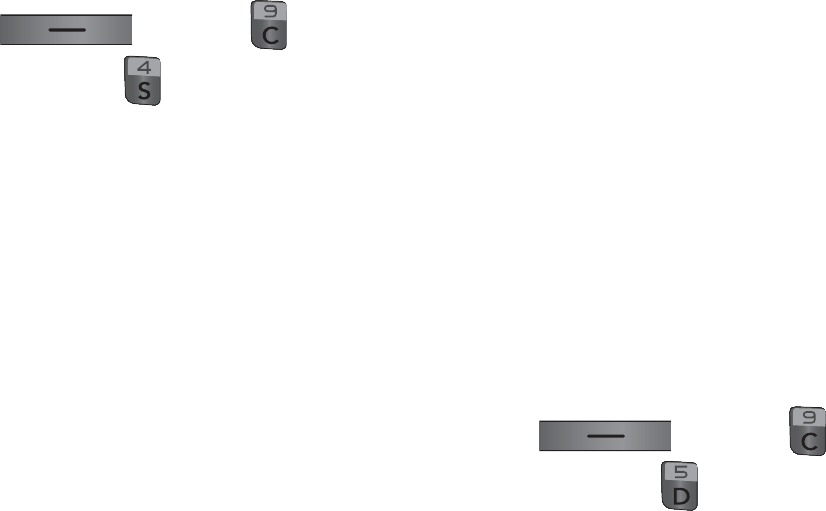
Other Files
When you receive files of an
undefined format (such as .vcs, .vcf,
etc.) via email, the files are saved in
this folder.
To access Other Files, from the
standby screen, press the left soft
key Menu, My
Folder, and Other Files.
The following options are available:
►
Send Via: Send the selected file
via Bluetooth or MMS.
►
Delete: Allows you to delete the
selected file.
►
Move: Allows you to move the
selected file to another folder.
►
Copy: Allows you to copy the
selected file to another folder.
►
Rename: Allows you to edit the
name of the selected file.
►
Select Multiple: Allows you to
select multiple files at once to
perform various functions.
►
Sort By: Allows you to sort the
files by Name, Date, and Type.
►
File Information: Allows you
to view information about the
selected file or used memory
space on your phone or memory
card.
File Manager
This function allows you to view
the content in your internal phone
memory and the external memory
card.
To access File Manager, from the
standby screen, press the left soft
key Menu, My
Folder, and File Manager.
My Folder
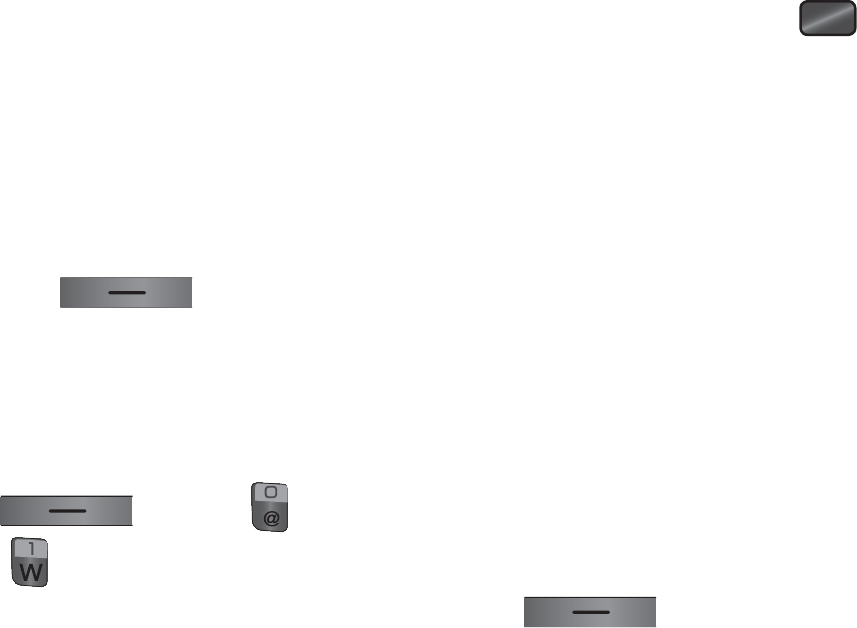
Alarm Clock
The alarm function allows you to
set up multiple separate alarms.
You can also set the time, repetition
interval, and alarm tone. If there
is no alarm setting, press the left
soft key New to add a
new alarm.
To access Alarm Clock, from the
standby screen, press the left soft
key Menu, Tools,
and Alarm Clock.
Alarm Options
►
Time: Input your desired alarm
time by specifying the hour and
minutes.
Set Time: You can also choose
a predefined amount of time
(15 Minutes Later, 30 Minutes
Later, 45 Minutes Later, 1 Hour
Later, Off).
►
Repeat: Select the desired
repeat mode (Once, Daily, Mon
~ Fri, Sat ~ Sun, Except Holiday,
Select Weekday).
►
Alarm Tone: Press List to
access the list of available Alarm
Tones.
►
Volume: Set the volume of the
alarm using up/down key.
►
Type: Select the Ring Alert Type
between Ring/ Vibrate/ Ring
& Vibrate and Vibrate after
Ring.
►
Memo: Input alarm name.
Press the Right soft key
Save to save your
new Alarm.
►
Snooze interval: Select the
snooze interval between 5
Minutes/ 15 Minutes/ 30
Minutes/ 45 Minutes / 1 Hour
and Off.
Calendar
When you enter this menu, a
calendar will be displayed. The red
square cursor is used to locate
a particular day. The bottom bar
Tools
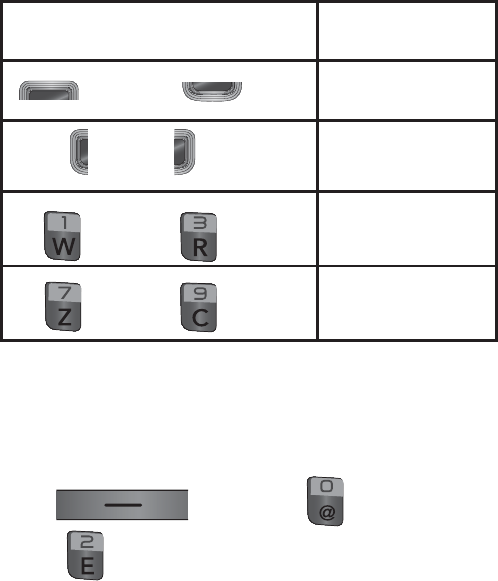
on the calendar indicates saved
schedules (if any) for that day.
This function helps you keep track
of your schedule. The phone can
sound an alarm tone if it has been
set for a specific schedule item.
The chart below shows the keys
that can be used to navigate the
Calendar:
Key
Description
key / key Weekly
key / key Daily
key /key / keykey Annually
key / key Monthly
To access Calendar, from the
standby screen, press the left soft
key Menu, Tools,
and Calendar.
The following options are available
when a Calendar event is selected
from the Calendar menu.
►
Search: Allows you to search
the saved schedule(s).
►
Delete: Allows you to delete the
selected schedule.
►
Send Schedule Via: Sends
the selected schedule by Text
Message, Multimedia Message,
or Bluetooth.
►
Set Holiday: Allows you to
set specific dates to display as
Holidays on your calendar.
►
Selective Delete: Allows you
to delete Old Schedules or All
Schedules selectively.
►
View All: Allows you to view all
saved schedules.
►
Go to Date: Allows you to jump
to a specific date.
►
Select Multiple: Allows you to
select multiple schedules in the
same day to delete or send to
another person.
Tools

Notepad
You can create up to a maximum of
30 memos.
To access Notepad, from the
standby screen, press the left soft
key Menu, Tools,
and Notepad.
Press the left soft key
New to create a new memo.
Input the memo and press
Save to save.
Calculator
The Calculator function allows you
to calculate simple mathematical
equations.
To access Calculator, from the
standby screen, press the left soft
key Menu, Tools,
and Calculator.
Tasks
This feature allows you to save and
manage a task.
1
2
To access Tasks, from the standby
screen, press the left soft key
Menu, Tools, and
Tasks.
To add a new task item, press
the left soft key New.
Input the Due Date, Note, Priority,
and Status information for the
new Task.
Press the left soft key
Save to save the Task item.
The following options are available
in the Task list:
►
Mark ‘Complete’: Allows you to
change the status of the selected
task as Completed.
►
Edit: Allows you to edit a saved
task.
►
Delete: Deletes the selected
task.
►
Selective Delete: Allows you
to delete All Completed/All Past
Tasks selectively.
1
2
3

►
Send Task Via: Enables the
selected task to be sent via Text
Message, Multimedia Message,
or Bluetooth.
►
Select Multiple: Allows you to
select multiple Tasks.
►
View Calendar: Allows you to
view the Calendar.
Stopwatch
This menu allows you to record
the elapsed time of an event. The
duration of an individual lap time
(up to 20 laps) and the total time
can also be displayed.
To access Stopwatch, from the
standby screen, press the left soft
key Menu, Tools,
and Stopwatch.
►
New Time
To start timing, press Start.
The running time is displayed as
HH.MM.SS.hh (hours, minutes,
seconds, hundredths of a
second).
1
During the timing, you can record
an individual lap time by pressing
the Left soft key
Lap. Up to 20 lap times can be
recorded.
You can stop or restart timing by
pressing again.
To reset the stop watch, press
Stop to stop the time, then
press the left soft key
Reset.
Tip Calculator
This feature allows you to quickly
and easily calculate the tip amount
based on the total bill as well as the
split of the total bill based on the
number of people.
To access Tip Calculator, from the
standby screen, press the left soft
key Menu, Tools,
and Tip Calculator.
2
3
4
Tools
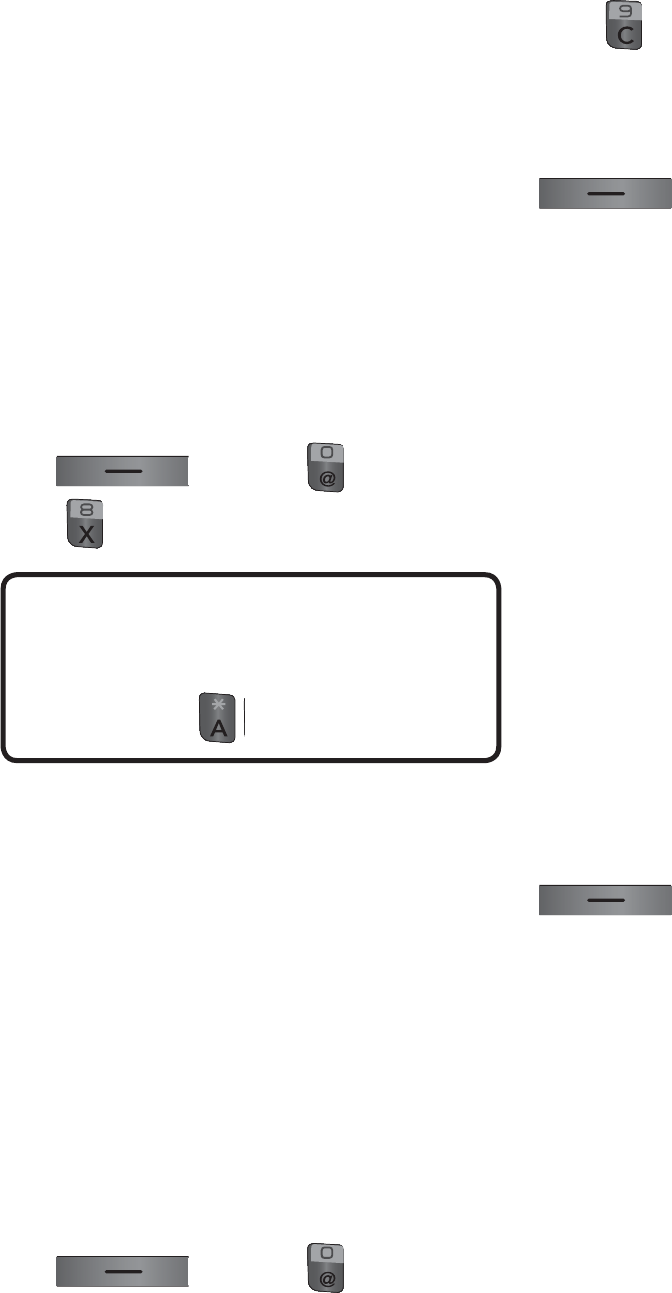
Unit Converter
This function allows you to convert
units of measurement.
There are 6 types of units that can
be converted: Area, Length, Weight,
Temperature, Volume, and Velocity.
To access Unit Converter, from the
standby screen, press the left soft
key Menu, Tools,
and Unit Converter.
Note
You can input a decimal by
pressing the key.key.
Record Voice
Allows you to record an audio clip
to your phone. The recorded audio
file is saved automatically in the
Audio menu.
To access Record Voice, from the
standby screen, press the left soft
key Menu, Tools,
and Record Voice.
The following options are available
when you press the left soft key
Options:
►
Record Mode: Sets the
recording mode to either MMS
Mode or General Mode.
►
Quality: Allows you to set the
quality of an audio clip. You
can set it to Fine, Normal, or
Economy
►
Set Storage Defaults: You can
set the default storage of the
recorded audio to the Phone
Memory or the Memory Card.
Pressing the right soft key
Gallery will take you to
the Audio gallery.
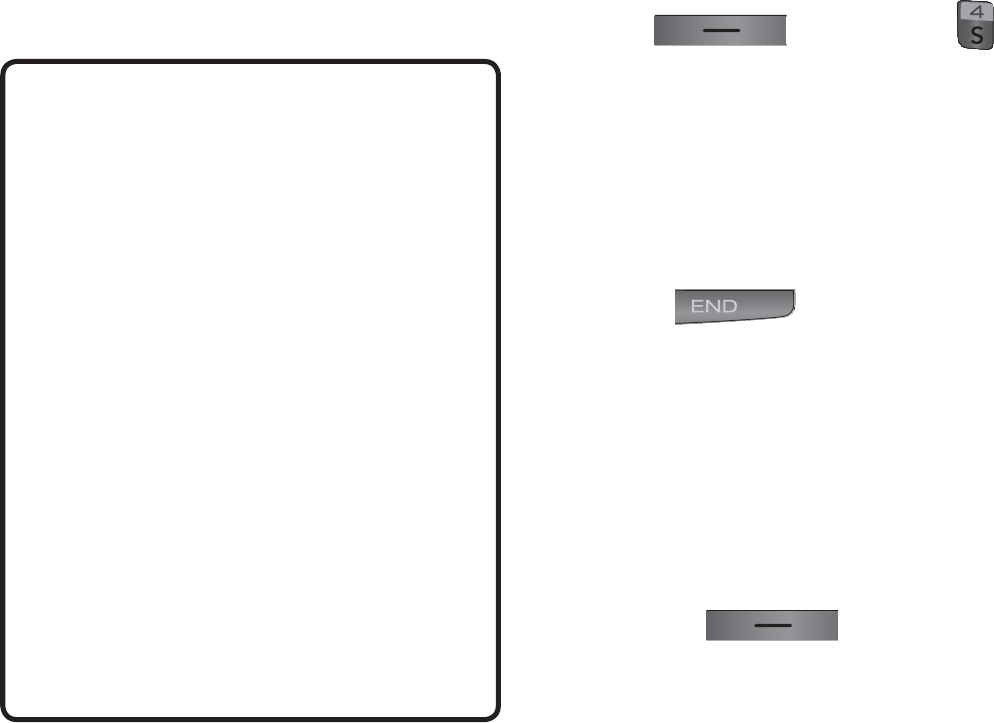
Mobile Web is one of the services
provided by and it gives you access
to all the cool things you can do
with your wireless phone.
Note
Check the availability of services,
pricing, and tariffs with your
network operator and/or the
service provider whose service
you wish to use. Service
providers will also give you
instructions on how to use their
services.
Please contact your service
provider to open an Internet
account.
Launch the Browser
To launch the browser from the
standby screen, press the right
soft key Menu and
Browser.
Once connected, the homepage is
displayed.
To exit the browser at any time,
press the [END] key.
Using the Browser
Once you are connected to the
Internet, the following menu options
are available when you press the
left soft key Options:
►
Zoom: Allows you to zoom in/out
for better look.
►
Home: Directs you to the
homepage.
►
Enter URL: Allows you to enter
URL you desire to visit.
►
Send Link: Allows you to send
link
Browser
►
Bookmarks: You can add
or save the current page to
Booksmarks or view the list
saved under Booksmarks.
►
Navigation Mode (sub -Back,
Forward, Refresh)
►
Search Text: Allows you to
search the text.
►
Recent Page: Allows you to
view your history of recently
viewed web sites.
►
Settings: Allows you to
set options for web pages,
appearance.
Menus for the Browser
You can surf the Internet using
either the phone keys or the
Browser menu.
Using the Navigation Keys
When surfing the Internet, the
navigation keys function similarly
from when the phone is on standby
mode.

Audio & Ringtones
This menu allows you to configure
the audio and ringtone settings for
your phone.
To access Audio & Ringtones,
from the standby screen, press
the left soft key Menu,
Settings, and Audio &
Ringtones.
Ringtone
►
Sounds: Allows you to set a
sound as the ringtone for your
phone.
►
Volume: Allows you to control
your Ringtone volume.
►
Alert Type: Supports 3 ring alert
types: Ring, Ring and Vibration,
and Ring after Vibration.
►
Increasing Ringtone: Allows
you to enable or disable the
Increasing Ringtone funcion,
which is played when you
receive an incoming call.
Note
Full length music tracks cannot
be set as either ringtones or
message tones.
Message Tone
►
Sounds: Allows you to set a
sound as your message tone.
►
Volume: Allows you to control
your Message Tone volume.
►
Alert Type: Supports 6 message
alert types: Ring Once, Ring
Every 2 Min., Ring Every 15
Min., Ring & Vibrate, Vibrate,
and Silent.
Settings
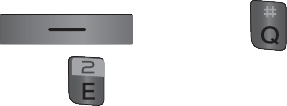
Alert Tone
►
Sounds: Allows you to select
a set of alert tones. Supports
2 alert tone types: Alert Tone 1
and Alert Tone 2.
►
Volume: This menu allows you
to control your Alert Tone volume.
►
Alert Type: You can select to
turn Alert Tones to Ring or Silent.
Keypad Tone
This menu option allows you to
select a tone that the phone sounds
when a key is pressed on the
dialpad. You can select an option
from Beep and Voice and set the
volume.
Multimedia
This menu allows you to control
your Multimedia volume.
Call
This menu allows you to control
your Call volume.
Phone Settings
This menu allows you to configure
the Phone Settings. To access
Phone Settings, from the standby
screen, press the left soft key
Menu, Settings,
and Phone Settings.
Date & Time
►
Set Date: This allows you to
enter the day, month, and year.
You can set to Auto Update with
the Auto Update menu.
►
Date Format:
ddd, MMM DD (day, month date)
MM/DD/YYYY (month/date/year)
DD/MM/YYYY (date/month/year)
YYYY/MM/DD (year/month/date)
►
Set Time: This allows you to
enter the current time. You can
choose the time format via the
Time Format menu option.
►
Time Format: 12 Hours/24
Hours
►
Auto Update: Allows you to
set the phone to automatically
update the time and date
according to the current local
time zone.
Languages
Allows you to change the language
for the display text on your phone.
This change will also affect the
Language Input mode.
Set Hotkeys
Allows you to change the
preferences on the Hotkeys that
are currently assigned for your
navigation keys (when in standby
mode).
Auto Key Lock
This allows you to set the amount
of time before your keys lock
automatically.
Set Flight Mode
This allows you to only use the
phone’s features that do not require
the use of the wireless network
when you are in an airplane or in
places where the wireless network
is prohibited. If you set the flight
mode on, the flight mode icon will
be displayed on the screen instead
of the network signal icon.
►
On: You cannot make (or receive)
any calls, including emergency
calls, or use other features that
require network coverage.
►
Off: You can deactivate the flight
mode to access the network.
Settings
Security
Various codes and passwords are
used to protect the features and
settings of your phone.
►
Phone Lock: You can use
a security code to avoid
unauthorized use of the phone.
If you set the Phone Lock to
When Power On, the phone
will request a security code
whenever you switch the phone
on. If you set the Phone Lock to
When SIM Card changed, your
phone will request a security
code only when you change your
SIM Card. If you set the Phone
Lock to Lock Phone Now, your
phone will lock immediately.
►
Change Codes: The Change
Codes feature allows you to
change your current password
to a new one. You must enter
the current password before you
can specify a new one. You can
change the access codes for:
Security Code
►
PTT Key Lock: Allows you to
enable or disable the PTT Key
Lock.
Reset Settings
This function allows you to restore
factory settings. To do this, you
need the security code.
►
Master Reset: Restores the
phone settings (e.g.: Audio,
Display, Language, Date & Time,
Bluetooth Settings) to default
values.
►
Master Clear: Deletes
downloaded/user created
contents (e.g.: images, videos)
from the phone and the external
memory card.
• Phone
- Deletes all downloaded/user
created images and audios
from the phone memory.
- Deletes personal information
stored in the phone memory
(e.g.: Address Book, Messages,
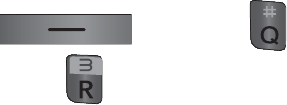
Tasks, Alarm, Calendar
Schedules).
- Restores the settings stored
in the phone memory to the
default values.
• Memory Card: Deletes all
contents from the external
memory card.
Display
This menu allows you to configure
your Display settings.
To access Display, from the standby
screen, press the left soft key
Menu, Settings,
and Display.
Shop Wallpapers
Connects to ’s Color Graphics
download site.
Wallpapers
This menu allows you to set a
picture or color as your background.
Fonts
You can configure the font size and
color of the font that your phone
uses.
Settings
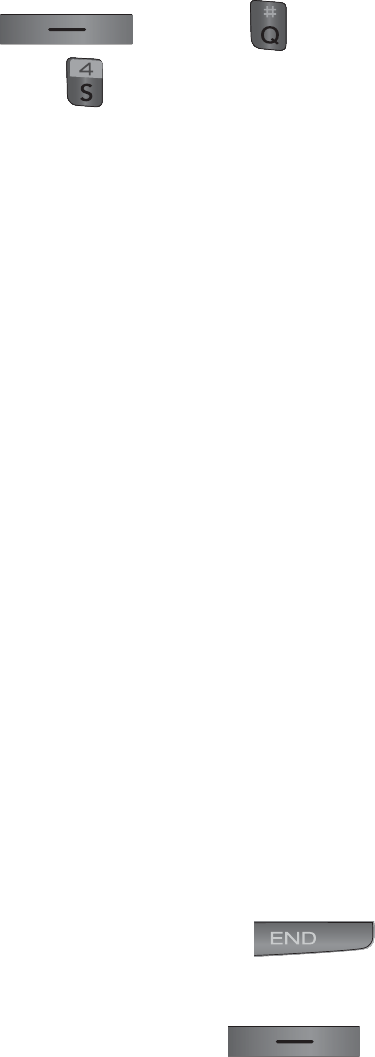
Clocks & Calendar
This feature allows you to select a
Clock or Calendar to display on the
standby screen.
Brightness
You can set the brightness of the
display screen.
Backlight Timer
Use this to set the duration of the
display backlight.
Color Schemes
Allows you to change the whole
look of your phone display to a
Black or White scheme.
Menu Styles
You can set the main menu style to
Icon or List view.
Call
This menu allows you to configure
your Call settings.
To access Call, from the standby
screen, press the left soft key
Menu, Settings,
and Call.
Send My Number
This network service allows you
to set your phone number to be
displayed or hidden from the person
you are calling. You can select
Set by Network if you prefer to
have different settings for different
service providers.
Answer Mode
This allows you to determine how to
answer the phone.
►
Any Key: Allows you to answer
an incoming call by pressing any
key, except the [END]
key, side volume keys, or the
right soft key Silent.

►
Send Key Only: Allows you to
only answer an incoming call by
pressing the [SEND]
key or left soft key
Accept.
Time & Cost
Allows you to view information
about Call Duration and Data
Counter.
TTY
Allows you to enable TTY Mode in
order to contact other TTY devices.
Select from TTY Full/TTY Talk/
TTY Hear/TTY Off.
Hearing Aid
Select from On/Off.
Bluetooth
Your phone has built-in Bluetooth
wireless technology, which makes
it possible for you to connect your
phone wirelessly to other Bluetooth
devices such as a hands-free
device, PC, laptop, or other phones.
The devices registered in your
phone can only be connected one
at a time (To make a connection to
the same type of device or change
Bluetooth preferences, disconnect
the existing device first).
You can also exchange, for
example, business cards, calendar
items, and pictures.
To access Bluetooth, from the
standby screen, press the left soft
key Menu, Settings,
and Bluetooth.
Settings

Hands-free profile
This appears when the hands-
free profile is used between the
hands-free device. This allows you
to call using a Bluetooth connection.
A2DP profile
This appears when the A2DP
profile is used between the stereo
headset device and the phone. This
allows you to listen to an audio
clip. A2DP is the Advanced Audio
Distribution Profile, which provides
support for streaming either mono
or stereo audio using Bluetooth.
Hands-free + A2DP profile
This appears when both
profiles of the hands-free and
the A2DP are used between the
compatible device and the phone.
This allows you to call and listen
to an audio clip using a Bluetooth
connection.
When using each device, see the
manual that comes with the device.
Note
We recommend that your phone
and the Bluetooth device you are
communicating with should be
no more than 10 meters apart.
The connection may be improved
if there are no solid objects
between your phone and the
other Bluetooth device.
Bluetooth Menu Options
►
Turn On/Off: Allows you to turn
your Bluetooth functionality on
or off.
►
Search New Device: This
function allows you to search for
and add new devices.
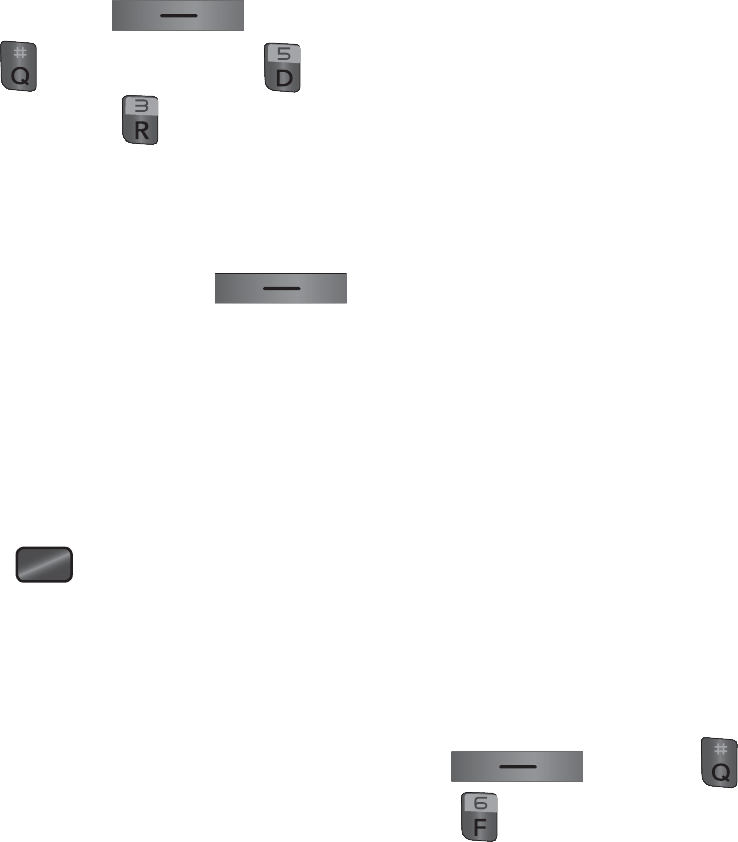
To pair with another
device
From the standby screen, press
the left soft key
Menu, Settings, and
Bluetooth, and Search
New Device.
If you want to stop searching,
press the right soft key
Stop.
All of the devices found are
displayed.
Select the desired device by
pressing Add and entering
the password.
►
My Devices: This function
allows you to view the list of all
devices that are paired with your
phone.
►
My Bluetooth Info: This menu
allows you to configure the
profile for Bluetooth.
- My device visibility: Allows
you to set to be Hidden or
1
2
3
4
Visible for 3 Minutes.
- Device Name: Allows you to
change the handset’s name
which can be seen by other
Bluetooth devices.
- Supported Services: Shows
you all services that the
handset supports.
- My Bluetooth Address:
Allows you to check the
handset bluetooth address.
Memory
This menu allows you to configure
your Memory settings.
To access Memory, from the
standby screen, press the left soft
key Menu, Settings,
and Memory.
Used Space
This function shows the memory
status of the handset and memory
card (if inserted).
Settings
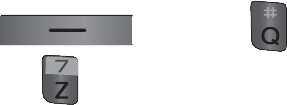
►
Phone Common
This function shows the Memory
Status of the phone and the
memory being used by Audio,
Image, Video, Multimedia
Message, Java, and Others types
of files.
►
Phone Reserved
This function shows the status
of the reserved memory used
by Text Messages, Contacts,
Calendar items, Tasks, and the
Notepad.
►
Memory Card
If your phone has a memory card
in the card slot, you can save
images, sounds, and videos onto
it. You can check the current
status of the external memory
card in this memory status
menu.
►
SIM Card
This function shows the status of
the SIM Card memory.
Set Storage Defaults
This menu allows you to set the
storage default location for internet
downloads, Bluetooth transfers, and
voice recordings. You can set each
case separately or choose to set all
of them at once.
Application Settings
This Menu allows you to configure
Application Settings.
To access Application Settings,
from the standby screen, press the
left soft key Menu,
Settings, and Application
Settings.
Messages
For more details, refer to Message
Settings on page 25.
Browser
This menu allows you to configure
the Browser settings.

Accounts
This includes the network
information used to connect the
browser to the Internet. Select the
desired account by highlighting
it and pressing the left soft key
Activate. This will
activate the account that will be
used for future connections.
►
Activate: Select the account
among the list of accounts,
so it can be used for future
connections.
►
View: Allows you to see the
specific account information.
The following options will be
available when you press on the
right soft key Options:
►
Edit: Allows you to change the
account information. This option
is not available for the default
Account.
►
Delete: Allows you to delete the
account.
►
New: Allows you to create new
account.
Note
•
You cannot edit and delete pre-
installed accounts.
•
In order to create a new
account, please fill in the
network information.
1. Account Name: Name
associated with new
account.
2. Homepage: Homepage URL.
•
has provided default settings
regarding account information.
•
Creating or editing an account
requires caution. The browser
cannot connect to the Internet
if the account information is
incorrect.
Settings

Appearance
You can choose the settings of
the browser appearance (Text
size, Character Encoding, Scrolling
Control, Show Image, JavaScript).
Cache
The web pages you have accessed
are stored in the phone memory.
This menu allows you to manage
that function.
►
Clear Cache: Remove all
cached data in the memory.
►
Allow Cache: Allows you to turn
the memory cache on or off.
Note
Cache is a type of buffer memory,
which is used to store data
temporarily, especially when it
is online.
Cookies
The information of services you
have accessed are stored in what is
called a Cookie.
From this menu, you can choose to
Allow Cookies or to Delete Cookies
that are already on your phone.
Screen Settings
You can change the settings of the
browser screen (Rendering mode,
Zoom, Mini-Map).
Security
A list of the available certificates
is shown.
►
Certificates: You can see the
list of certificates and view them
in detail.
►
Clear Session: Removes the
secure session.

Navigation Mode
You can change the methods of
browser navigation.
►
4 Way Navigation: The cursor
of the browser moves scroll
amounts or follows hyperlinks.
►
Mouse Pointer: You can move
the cursor like a mouse pointer.
Secure Pop-up
You can activate or deactivate the
pop-up which indicates a secure
page.
Browser Shortcut
If set to On, you can use the
alternative browser (found in Menu
> My Stuff > Applications
> Browser) more quickly and
conveniently with the key pad in the
phone. If Browser Shortcut is on,
the following shortcuts are available:
1. Enter URL
3. Add This Page
5. Full Screen
7. Page Down
9. Search Text
*. View Bookmarks
2. Recent Pages
4. Page Up
6. Page Overview
8. New Window
0. Zoom In
#. Zoom Out
Phone Information
This menu is used to view My
Numbers, Manufacturer, Model
Name, Device ID, Hardware Version,
Software Version, Language, and
DM Client Version.
To access Phone Information,
from the standby screen, press
the left soft key Menu,
Settings, and Phone
Information.
Settings
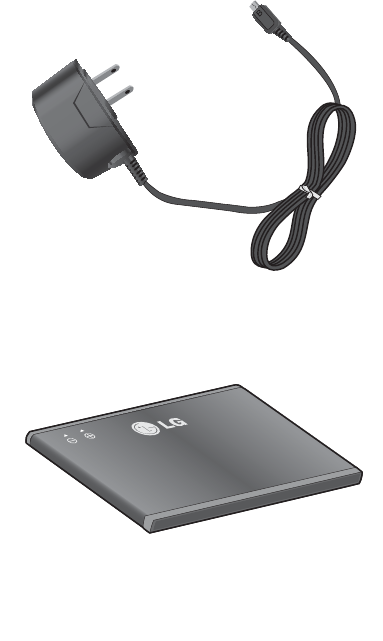
Accessories
There are a variety of accessories available for your mobile phone, some
of which may be sold separately. You can select these options according to
your personal communication requirements. Consult your local dealer for
availability.
Travel Adapter
This adapter allows you to charge the battery. It
supports standard US 120 Volt 60Hz outlets.
Battery
Standard battery is available.
Note
• Always use genuine LG accessories. Failure to do this may invalidate your
warranty.
• Accessories may be different in different regions; please check with our
regional service company or agent for further enquiries.
Important Information
This user guide contains
important information on the
use and operation of this phone.
Please read all the information
carefully for optimal performance
and to prevent any damage to
or misuse of the phone. Any
changes or modifications not
expressly approved in this user
guide could void your warranty
for this equipment. Any changes
or modifications not expressly
approved by the manufacturer could
void the user’s authority to operate
the equipment.
Before You Start
Safety Instructions
WARNING! To reduce the possibility
of electric shock, do not expose
your phone to high humidity areas,
such as the bathroom, swimming
pool, etc.
Always store your phone away
from heat. Never store your phone
in settings that may expose it to
temperatures less than 32°F or
greater than 104°F, such as outside
during extreme weather conditions
or in your car on a hot day.
Exposure to excessive cold or heat
will result in malfunction, damage
and/or catastrophic failure.
Be careful when using your
phone near other electronic
devices. RF emissions from
your mobile phone may affect
nearby in adequately shielded
electronic equipment. You should
consult with manufacturers of any
personal medical devices such as
pacemakers and hearing aides to
determine if they are susceptible
to interference from your mobile
phone. Turn off your phone in a
medical facility or at a gas station.
Never place your phone in a
microwave oven as this will cause
the battery to explode.
For Your Safety
IMPORTANT! Please read the TIA
SAFETY INFORMATION on page 78
before using your phone.
Safety Information
Read these simple guidelines.
Breaking the rules may be
dangerous or illegal. Further
detailed information is given in this
user guide.
►
Do not disassemble this unit.
Take it to a qualified service
technician when repair work is
required.
►
Keep away from electrical
appliances such as TVs, radios,
and personal computers.
►
The unit should be kept away
from heat sources such as
radiators or cookers.
►
Do not drop.
►
Do not subject this unit to
mechanical vibration or shock.
►
The coating of the phone may be
damaged if covered with wrap or
vinyl wrapper.
►
Use dry cloth to clean the
exterior of the unit. (Do not use
solvent such as benzene, thinner
or alcohol.)
►
Do not subject this unit to
excessive smoke or dust.
►
Do not keep the phone next to
credit cards or transport tickets;
it can affect the information on
the magnetic strips.
►
Do not tap the screen with a
sharp object; otherwise, it may
damage the phone.
►
Do not expose the phone to
liquid or moisture.
►
Use the accessories like an
earphone cautiously. Do not
touch the antenna unnecessarily.
Memory card information
and care
►
The memory card cannot be
used for recording copyright-
protected data.
►
Keep the memory card out of the
small children’s reach.
►
Do not leave the memory card in
extremely hot location.
►
Do not disassemble or modify
the memory card.
FCC RF Exposure
Information
WARNING! Read this information
before operating the phone.
In August 1996, the Federal
Communications Commission (FCC)
of the United States, with its action
in Report and Order FCC 96-326,
adopted an updated safety standard
for human exposure to radio
frequency (RF) electromagnetic
energy emitted by FCC regulated
transmitters. Those guidelines are
consistent with the safety standard
previously set by both U.S. and
international standards bodies.
The design of this phone complies
with the FCC guidelines and these
international standards.
CAUTION
Use only the supplied and approved
antenna. Use of unauthorized
antennas or modifications could
impair call quality, damage
the phone, void your warranty
and/or result in violation of FCC
regulations. Do not use the phone
with a damaged antenna. If a
damaged antenna comes into
contact with skin, a minor burn may
result. Contact your local dealer for
a replacement antenna.
For Your Safety
Cautions for Battery
►
Do not disassemble.
►
Do not short-circuit.
►
Do not expose to high
temperature:
60°C (140°F).
►
Do not incinerate.
Battery Disposal
►
Please dispose of your battery
properly or bring to your local
wireless carrier for recycling.
►
Do not dispose in fire or with
hazardous or flammable
materials.
Adapter (Charger)
Cautions
►
Using the wrong battery charger
could damage your phone and
void your warranty.
►
The adapter or battery charger is
intended for indoor use only.
For Your Safety
Do not expose the adapter or
battery charger to direct sunlight or
use it in places with high humidity,
such as the bathroom.
Avoid damage to your
hearing
►
Damage to your hearing can
occur if you are exposed to loud
sound for long periods of time.
We therefore recommend that
you do not turn on or off the
handset close to your ear. We
also recommend that music
and call volumes are set to a
reasonable level.
►
If you are listening to music
while out and about, please
ensure that the volume is at a
reasonable level so that you are
aware of your surroundings. This
is particularly imperative when
attempting to cross the street.
TIA Safety Information
Provided herein is the complete
TIA Safety Information for Wireless
Handheld phones. Inclusion of
the text covering Pacemakers,
Hearing Aids, and Other Medical
Devices is required in the owner’s
manual for CTIA Certification. Use
of the remaining TIA language is
encouraged when appropriate.
Exposure to Radio
Frequency Signal
Your wireless handheld portable
telephone is a lowpower radio
transmitter and receiver. When it is
ON, it receives and also sends out
radio frequency (RF) signals.
In August, 1996, the Federal
Communications Commissions
(FCC) adopted RF exposure
guidelines with safety levels for
handheld wireless phones. Those
guidelines are consistent with
the safety standards previously
set by both U.S. and international
standards bodies:
ANSI C95.1 (1992) *
NCRP Report 86 (1986)
ICNIRP (1996)
Those standards were based
on comprehensive and periodic
evaluations of the relevant
scientific literature. For example,
over 120 scientists, engineers,
and physicians from universities,
government health agencies, and
industry reviewed the available body
of research to develop the ANSI
Standard (C95.1).
* American National Standards
Institute; National Council
on Radiation Protection and
Measurements; International
Commission on Non-Ionizing
Radiation Protection
The design of your phone complies
with the FCC guidelines (and those
standards).
Safety Guidelines
Antenna Care
Use only the supplied or an
approved replacement antenna.
Unauthorized antennas,
modifications, or attachments could
damage the phone and may violate
FCC regulations.
Phone Operation
NORMAL POSITION: Hold the phone
as you would any other telephone
with the antenna pointed up and
over your shoulder.
Tips on Efficient
Operation
For your phone to operate most
efficiently:
►
Do not touch the antenna
unnecessarily when the phone
is in use. Contact with the
antenna affects call quality and
may cause the phone to operate
at a higher power level than
otherwise needed.
Driving
Check the laws and regulations on
the use of wireless phones in the
areas where you drive. Always obey
them. Also, if using your phone
while driving, please:
►
Give full attention to driving
- driving safely is your first
responsibility;
►
Use hands-free operation, if
available;
►
Pull off the road and park before
making or answering a call if
driving conditions so require.
Electronic Devices
Most modern electronic equipment
is shielded from RF signals.
However, certain electronic
equipment may not be shielded
against the RF signals from your
wireless phone.
Pacemakers
The Health Industry Manufacturers
Association recommends that a
minimum separation of 15cm (6
inches) be maintained between
a handheld wireless phone and
a pacemaker to avoid potential
interference with the pacemaker.
These recommendations are
consistent with the independent
research by and recommendations
of Wireless Technology Research.
Persons with pacemakers:
►
Should ALWAYS keep the phone
more than 15cm (6 inches) from
their pacemaker when the phone
is turned ON;
►
Should not carry the phone in a
breast pocket.
►
Should use the ear opposite
the pacemaker to minimize the
potential for interference.
►
If you have any reason to
suspect that interference is
taking place, turn your phone
OFF immediately.
Hearing Aids
Some digital wireless phones may
interfere with some hearing aids. In
the event of such interference, you
may want to consult .
Other Medical Devices
If you use any other personal
medical device, consult the
manufacturer of your device to
determine if they are adequately
shielded from external RF energy.
Your physician may be able to assist
you in obtaining this information.
Health Care Facilities
Turn your phone OFF in health
care facilities when any regulations
posted in these areas instruct you
to do so. Hospitals or health care
facilities may use equipment that
could be sensitive to external RF
energy.
Safety Guidelines
Vehicles
RF signals may affect improperly
installed or inadequately
shielded electronic systems in
motor vehicles. Check with the
manufacturer or its representative
regarding your vehicle.
You should also consult the
manufacturer of any equipment that
has been added to your vehicle.
Posted Facilities
Turn your phone OFF in any facility
where posted notices so require.
Aircraft
FCC regulations prohibit using your
phone while in the air. Turn your
phone OFF before boarding an
aircraft.
Blasting Areas
To avoid interfering with blasting
operations, turn your phone OFF
when in a ‘blasting areas or in areas
posted: ‘Turn off two-way radio’.
Obey all signs and instructions.
Potentially Explosive
Atmosphere
Turn your phone OFF when in any
area with a potentially explosive
atmosphere and obey all signs and
instructions. Sparks in such areas
could cause an explosion or fire
resulting in bodily injury or even
death.
Areas with a potentially explosive
atmosphere are often, but not
always, marked clearly. Potential
areas may include: fueling areas
(such as gasoline stations); below
deck on boats; fuel or chemical
transfer or storage facilities;
vehicles using liquefied petroleum
gas (such as propane or butane);
areas where the air contains
chemicals or particles (such as
grain, dust, or metal powders); and
any other area where you would
normally be advised to turn off your
vehicle engine.
For Vehicles Equipped
with an Air Bag
An air bag inflates with great force.
DO NOT place objects, including
either installed or portable wireless
equipment, in the area over the air
bag or in the air bag deployment
area. If in-vehicle wireless
equipment is improperly installed
and the air bag inflates, serious
injury could result.
Safety Information
Please read and observe the
following information for safe and
proper use of your phone and to
prevent damage. Also, keep the
user guide in an accessible place at
all the times after reading it.
Do not disassemble or open
crush, bend or deform, puncture
or shred.
Do not modify or remanufacture,
attempt to insert foreign objects
into the battery, immerse or
expose to water or other liquids,
expose to fire, explosion or other
hazard.
Only use the battery for the
system for which it is specified.
Only use the battery with a
charging system that has been
qualified with the system per
IEEE-Std-1725-2006. Use
of an unqualified battery or
charger may present a risk of
fire, explosion, leakage, or other
hazard
►
►
►
►
Safety Guidelines
Do not short circuit a battery or
allow metallic conductive objects
to contact battery terminals.
Replace the battery only with
another battery that has been
qualified with the system per
IEEE-Std-1725-2006. Use of an
unqualified battery may present
a risk of fire, explosion, leakage
or other hazard.
Promptly dispose of used
batteries in accordance with
local regulations.
Battery usage by children should
be supervised.
Avoid dropping the phone or
battery. If the phone or battery
is dropped, especially on a hard
surface, and the user suspects
damage, take it to a service
center for inspection.
Improper battery use may result
in a fire, explosion or other
hazard.
►
►
►
►
►
►
The phone shall only be
connected to USB products
that bear the USB-IF logo or
have completed the USB-IF
compliance program.
Charger and Adapter
Safety
The charger and adapter are
intended for indoor use only.
Battery Information and
Care
Please dispose of your battery
properly or take it to your local
wireless carrier for recycling.
The battery does not need
to be fully discharged before
recharging.
Use only LG-approved chargers
specific to your phone model
since they are designed to
maximize battery life.
►
►
►
►
►
Do not disassemble or impact
the battery as it may cause
electric shock, short-circuit, and
fire. Store the battery in a place
out of reach of children.
Keep the battery’s metal
contacts clean.
Replace the battery when it
no longer provides acceptable
performance. The battery can be
recharged several hundred times
before replacement.
Recharge the battery after long
periods of non-use to maximize
battery life.
Battery life will vary due to usage
patterns and environmental
conditions.
Use of extended backlighting,
Mobile Web Browsing, and data
connectivity kits affect battery
life and talk/standby times.
►
►
►
►
►
►
The self-protection function of
the battery cuts the power of the
phone when its operation is in
an abnormal state. In this case,
remove the battery from the
phone, reinstall it, and turn the
phone on.
Explosion, Shock, and
Fire Hazards
Do not put your phone in a place
subject to excessive dust and
keep the minimum required
distance between the power
cord and heat sources.
Unplug the power cord prior
to cleaning your phone, and
clean the power plug pin when
it is dirty.
When using the power
plug, ensure that it is firmly
connected. If it is not, it may
cause excessive heat or fire.
►
►
►
►
Safety Guidelines
If you put your phone in a pocket
or bag without covering the
receptacle of the phone (power
plug pin), metallic articles (such
as a coin, paperclip or pen) may
short-circuit the phone. Always
cover the receptacle when not
in use.
Do not short-circuit the battery.
Metallic articles such as a coin,
paperclip or pen in your pocket
or bag may short-circuit the +
and – terminals of the battery
(metal strips on the battery)
upon moving. Short-circuit of the
terminal may damage the battery
and cause an explosion.
General Notice
Using a damaged battery or
placing a battery in your mouth
may cause serious injury.
Do not place items containing
magnetic components such as
a credit card, phone card, bank
►
►
►
►
book or subway ticket near your
phone. The magnetism of the
phone may damage the data
stored in the magnetic strip.
Talking on your phone for a long
period of time may reduce call
quality due to heat generated
during use.
When the phone is not used for
a long period time, store it in a
safe place with the power cord
unplugged.
Using the phone in proximity to
receiving equipment (i.e., TV or
radio) may cause interference to
the phone.
Do not use the phone if the
antenna is damaged. If a
damaged antenna contacts
skin, it may cause a slight burn.
Please contact an LG Authorized
Service Centre to replace the
damaged antenna.
►
►
►
►
Do not immerse your phone in
water. If this happens, turn it
off immediately and remove the
battery. If the phone does not
work, take it to an LG Authorized
Service Centre.
Do not paint your phone.
The data saved in your phone
might be deleted due to careless
use, repair of the phone, or
upgrade of the software. Please
backup your important phone
numbers. (Ring tones, text
messages, voice messages,
pictures, and videos could also
be deleted.) The manufacturer is
not liable for damage due to the
loss of data.
When you use the phone in
public places, set the ring tone
to vibration so as not to disturb
others.
Do not turn your phone on or off
when putting it in your ear.
►
►
►
►
►
FDA Consumer Update
The U.S. Food and Drug
Administration Centre for Devices
and Radiological Health Consumer
Update on Mobile Phones.
1. Do wireless phones pose a
health hazard?
The available scientific evidence
does not show that any health
problems are associated with
using wireless phones. There is
no proof, however, that wireless
phones are absolutely safe.
Wireless phones emit low levels
of radiofrequency energy (RF) in
the microwave range while being
used. They also emit very low
levels of RF when in the standby
mode. Whereas high levels of RF
can produce health effects (by
heating tissue), exposure to low
level RF that does not produce
heating effects causes no known
adverse health effects. Many
studies of low level RF exposures
Safety Guidelines
have not found any biological
effects. Some studies have
suggested that some biological
effects may occur, but such
findings have not been confirmed
by additional research. In some
cases, other researchers have
had difficulty in reproducing
those studies, or in determining
the reasons for inconsistent
results.
2. What is the FDA’s role
concerning the safety of
wireless phones?
Under the law, the FDA does not
review the safety of radiation-
emitting consumer products
such as wireless phones before
they can be sold, as it does
with new drugs or medical
devices. However, the agency
has authority to take action if
wireless phones are shown to
emit radiofrequency energy (RF)
at a level that is hazardous to
the user. In such a case, the FDA
could require the manufacturers
of wireless phones to notify users
of the health hazard and to repair,
replace, or recall the phones so
that the hazard no longer exists.
Although the existing scientific
data do not justify FDA regulatory
actions, the FDA has urged the
wireless phone industry to take
a number of steps, including the
following:
►
Support needed research into
possible biological effects
of RF of the type emitted by
wireless phones;
►
Design wireless phones in a
way that minimizes any RF
exposure to the user that
is not necessary for device
function; and
►
Cooperate in providing users
of wireless phones with the
best possible information on
possible effects of wireless
phone use on human health.
The FDA belongs to an
interagency working group
of the federal agencies that
have responsibility for different
aspects of RF safety to ensure
coordinated efforts at the federal
level. The following agencies
belong to this working group:
►
National Institute for
Occupational Safety and
Health
►
Environmental Protection
Agency
►
Occupational Safety and
Health Administration
(Administración de la
seguridad y salud laborales)
►
Occupational Safety and
Health Administration
►
National Telecommunications
and Information Administration
The National Institutes of Health
participates in some interagency
working group activities, as well.
The FDA shares regulatory
responsibilities for wireless
phones with the Federal
Communications Commission
(FCC). All phones that are sold in
the United States must comply
with FCC safety guidelines that
limit RF exposure. The FCC relies
on the FDA and other health
agencies for safety questions
about wireless phones.
The FCC also regulates the base
stations that the wireless phone
networks rely upon. While these
base stations operate at higher
power than do the wireless
phones themselves, the RF
exposures that people get from
these base stations are typically
thousands of times lower than
those they can get from wireless
phones. Base stations are thus
not the subject of the safety
Safety Guidelines
questions discussed in this
document.
3. What kinds of phones are the
subject of this update?
The term ‘wireless phone’ refers
here to handheld wireless phones
with built-in antennas, often
called ‘cell’, ‘mobile’, or ‘PCS’
phones. These types of wireless
phones can expose the user
to measurable radiofrequency
energy (RF) because of the short
distance between the phone
and the user’s head. These RF
exposures are limited by FCC
safety guidelines that were
developed with the advice of the
FDA and other federal health and
safety agencies. When the phone
is located at greater distances
from the user, the exposure to
RF is drastically lower because a
person’s RF exposure decreases
rapidly with increasing distance
from the source. The so-called
‘cordless phones’, which have
a base unit connected to the
telephone wiring in a house,
typically operate at far lower
power levels, and thus produce
RF exposures far below the FCC
safety limits.
4. What are the results of the
research done already?
The research done thus far has
produced conflicting results, and
many studies have suffered from
flaws in their research methods.
Animal experiments investigating
the effects of radiofrequency
energy (RF) exposures
characteristic of wireless phones
have yielded conflicting results
that often cannot be repeated
in other laboratories. A few
animal studies, however, have
suggested that low levels of RF
could accelerate the development
of cancer in laboratory animals.
However, many of the studies
that showed increased tumor
development used animals that
had been genetically engineered
or treated with cancer causing
chemicals so as to be pre-
disposed to develop cancer in the
absence of RF exposure. Other
studies exposed the animals to
RF for up to 22 hours per day.
These conditions are not similar
to the conditions under which
people use wireless phones, so
we don’t know with certainty
what the results of such studies
mean for human health. Three
large epidemiology studies
have been published since
December 2000. Between them,
the studies investigated any
possible association between
the use of wireless phones and
primary brain cancer, glioma,
meningioma, or acoustic
neuroma, tumors of the brain or
salivary gland, leukemia, or other
cancers. None of the studies
demonstrated the existence of
any harmful health effects from
wireless phone RF exposures.
However, none of the studies
can answer questions about
long-term exposures, since the
average period of phone use in
these studies was around three
years.
5. What research is needed to
decide whether RF exposure
from wireless phones poses a
health risk?
A combination of laboratory
studies and epidemiological
studies of people actually using
wireless phones would provide
some of the data that are
needed. Lifetime animal exposure
studies could be completed in a
few years. However, very large
numbers of animals would be
needed to provide reliable proof
of a cancer promoting effect
if one exists. Epidemiological
studies can provide data that
is directly applicable to human
populations, but 10 or more
Safety Guidelines
years follow-up may be needed
to provide answers about some
health effects, such as cancer.
This is because the interval
between the time of exposure to
a cancer-causing agent and the
time tumors develop - if they do-
may be many, many years. The
interpretation of epidemiological
studies is hampered by
difficulties in measuring actual RF
exposure during day-to-day use
of wireless phones. Many factors
affect this measurement, such as
the angle at which the phone is
held, or which model of phone is
used.
6. What is the FDA doing to find
out more about the possible
health effects of wireless
phone RF?
The FDA is working with the
U.S. National Toxicology Program
and with groups of investigators
around the world to ensure that
high priority animal studies are
conducted to address important
questions about the effects
of exposure to radiofrequency
energy (RF). The FDA has
been a leading participant in
the World Health Organization
International Electromagnetic
Fields (EMF) Project since its
inception in 1996. An influential
result of this work has been
the development of a detailed
agenda of research needs that
has driven the establishment of
new research programs around
the world. The project has also
helped develop a series of public
information documents on EMF
issues. The FDA and the Cellular
Telecommunications & Internet
Association (CTIA) have a formal
Cooperative Research and
Development Agreement (CRADA)
to do research on wireless phone
safety. The FDA provides the
scientific oversight, obtaining
input from experts in government,
industry, and academic
organizations. CTIA-funded
research is conducted through
contracts with independent
investigators. The initial research
will include both laboratory
studies and studies of wireless
phone users. The CRADA will
also include a broad assessment
of additional research needs in
the context of the latest research
developments around the world.
7. How can I find out how
much radio frequency energy
exposure I can get by using
my wireless phone?
All phones sold in the United
States must comply with Federal
Communications Commission
(FCC) guidelines that limit radio
frequency energy (RF) exposures.
The FCC established these
guidelines in consultation with
the FDA and the other federal
health and safety agencies.
The FCC limit for RF exposure
from wireless telephones is
set at a Specific Absorption
Rate (SAR) of 1.6 watts per
kilogram (1.6 W/kg). The FCC
limit is consistent with the
safety standards developed by
the Institute of Electrical and
Electronic Engineering (IEEE) and
the National Council on Radiation
Protection and Measurement.
The exposure limit takes into
consideration the body’s ability
to remove heat from the tissues
that absorb energy from the
wireless phone and is set well
below levels known to have
effects. Manufacturers of wireless
phones must report the RF
exposure level for each model
of phone to the FCC. The FCC
website (http://www.fcc.gov/)
gives directions for locating the
FCC identification number on
your phone so you can find your
phone’s RF exposure level in the
online listing.
Safety Guidelines
8. What has the FDA done to
measure the radio frequency
energy coming from wireless
phones?
The Institute of Electrical and
Electronic Engineers (IEEE)
is developing a technical
standard for measuring the
radio frequency energy (RF)
exposure from wireless phones
and other wireless handsets
with the participation and
leadership of FDA scientists
and engineers. The standard,
‘Recommended Practice for
Determining the Spatial- Peak
Specific Absorption Rate (SAR) in
the Human Body Due to Wireless
Communications Devices:
Experimental Techniques’, sets
forth the first consistent test
methodology for measuring the
rate at which RF is deposited
in the heads of wireless phone
users. The test method uses
a tissuesimulating model of
the human head. Standardized
SAR test methodology is
expected to greatly improve the
consistency of measurements
made at different laboratories
on the same phone. SAR is the
measurement of the amount of
energy absorbed in tissue, either
by the whole body or a small
part of the body. It is measured
in watts/kg (or milliwatts/g) of
matter. This measurement is
used to determine whether a
wireless phone complies with
safety guidelines.
9. What steps can I take to
reduce my exposure to
radiofrequency energy from
my wireless phone?
If there is a risk from these
products - and at this point
we do not know that there is
- it is probably very small. But
if you are concerned about
avoiding even potential risks,
you can take a few simple steps
to minimize your exposure to
radiofrequency energy (RF).
Since time is a key factor in
how much exposure a person
receives, reducing the amount
of time spent using a wireless
phone will reduce RF exposure.
If you must conduct extended
conversations by wireless
phone every day, you could
place more distance between
your body and the source of
the RF, since the exposure level
drops off dramatically with
distance. For example, you could
use a headset and carry the
wireless phone away from your
body or use a wireless phone
connected to a remote antenna.
Again, the scientific data do
not demonstrate that wireless
phones are harmful. But if you
are concerned about the RF
exposure from these products,
you can use measures like those
described above to reduce your
RF exposure from wireless phone
use.
10. What about children using
wireless phones?
The scientific evidence does
not show a danger to users
of wireless phones, including
children and teenagers. If you
want to take steps to lower
exposure to radiofrequency
energy (RF), the measures
described above would apply to
children and teenagers using
wireless phones. Reducing the
time of wireless phone use
and increasing the distance
between the user and the RF
source will reduce RF exposure.
Some groups sponsored by
other national governments
have advised that children
be discouraged from using
wireless phones at all. For
example, the government in
the United Kingdom distributed
leaflets containing such a
Safety Guidelines
recommendation in December
2000. They noted that no
evidence exists that using a
wireless phone causes brain
tumors or other ill effects. Their
recommendation to limit wireless
phone use by children was
strictly precautionary; it was not
based on scientific evidence that
any health hazard exists.
11. What about wireless phone
interference with medical
equipment?
Radio frequency energy (RF) from
wireless phones can interact with
some electronic devices. For this
reason, the FDA helped develop a
detailed test method to measure
electromagnetic interference
(EMI) of implanted cardiac
pacemakers and defibrillators
from wireless telephones. This
test method is now part of a
standard sponsored by the
Association for the Advancement
of Medical instrumentation
(AAMI). The final draft, a joint
effort by the FDA, medical
device manufacturers, and many
other groups, was completed
in late 2000. This standard will
allow manufacturers to ensure
that cardiac pacemakers and
defibrillators are safe from
wireless phone EMI. The FDA
has tested hearing aids for
interference from handheld
wireless phones and helped
develop a voluntary standard
sponsored by the Institute
of Electrical and Electronic
Engineers (IEEE). This standard
specifies test methods and
performance requirements
for hearing aids and wireless
phones so that no interference
occurs when a person uses
a ‘compatible’ phone and a
‘compatible’ hearing aid at the
same time. This standard was
approved by the IEEE in 2000.
The FDA continues to monitor
the use of wireless phones for
possible interactions with other
medical devices. Should harmful
interference be found to occur,
the FDA will conduct testing to
assess the interference and work
to resolve the problem.
12. Where can I find additional
information?
For additional information, please
refer to the following resources:
FDA web page on wireless phones
(http://www.fda.gov/Radiation-
EmittingProducts/
RadiationEmittingProductsand
Procedures/HomeBusinessand
Entertainment/CellPhones/
default.htm)
Federal Communications
Commission (FCC) RF Safety
Program
(http://www.fcc.gov/oet/rfsafety)
International Commission on Non-
lonizing Radiation Protection
(http://www.icnirp.de)
World Health Organization (WHO)
International EMF Project
(http://www.who.int/peh-emf/
project/es)
National Radiological Protection
Board (UK)
(http://www.nrpb.org.uk/radiation)
10 Driver Safety Tips
Your wireless phone gives you the
powerful ability to communicate by
voice almost anywhere, anytime.
An important responsibility
accompanies the benefits of
wireless phones, one that every
user must uphold.
When operating a car, driving is
your first responsibility.
When using your wireless phone
behind the wheel of a car, practice
good common sense and remember
the following tips:
Get to know your wireless phone
and its features such as speed
dial and redial. Carefully read
1
Safety Guidelines
your instruction manual and learn
to take advantage of valuable
features most phones offer,
including automatic redial and
memory. Also, work to memorize
the phone keypad so you can use
the speed dial function without
taking your attention off the road.
When available, use a hands-free
device. A number of hands-free
wireless phone accessories are
readily available today. Whether
you choose an installed mounted
device for your wireless phone or
a speaker phone accessory, take
advantage of these devices if
available to you.
Position your wireless phone
within easy reach. Make sure you
place your wireless phone within
easy reach and where you can
reach it without removing your
eyes from the road. If you get an
incoming call at an inconvenient
time, if possible, let your
voicemail answer it for you.
2
3
Suspend conversations during
hazardous driving conditions or
situations. Let the person you
are speaking with know you are
driving; if necessary, suspend the
call in heavy traffic or hazardous
weather conditions. Rain, sleet,
snow and ice can be hazardous,
but so is heavy traffic. As a driver,
your first responsibility is to pay
attention to the road.
Do not take notes or look up
phone numbers while driving. If
you arereading an address book
or business card, or writing a
“to-do” list while driving a car,
you are not watching where you
are going. It is common sense.
Don’t get caught in a dangerous
situation because you are
reading or writing and not paying
attention to the road or nearby
vehicles.
Dial sensibly and assess the
traffic; if possible, place calls
when you are not moving or
4
5
6
before pulling into traffic. Try to
plan your calls before you begin
your trip or attempt to coincide
your calls with times you may be
stopped at a stop sign, red light
or otherwise stationary. But if you
need to dial while driving, follow
this simple tip— dial only a few
numbers, check the road and
your mirrors, then continue.
Do not engage in stressful or
emotional conversations that
may be distracting. Stressful or
emotional conversations and
driving do not mix; they are
distracting and even dangerous
when you are behind the wheel
of a car. Make people you are
talking with aware you are
driving and if necessary, suspend
conversations which have the
potential to divert your attention
from the road.
Use your wireless phone to call
for help. Your wireless phone
is one of the greatest tools you
7
8
can own to protect yourself
and your family in dangerous
situations — with your phone
at your side, help is only three
numbers away. Dial 911 or other
local emergency number in the
case of fire, traffic accident, road
hazard or medical emergency.
Remember, it is a free call on
your wireless phone!
Use your wireless phone to help
others in emergencies. Your
wireless phone provides you a
perfect opportunity to be a “Good
Samaritan” in your community. If
you see an auto accident, crime
in progress or other serious
emergency where lives are in
danger, call 911 or other local
emergency number, as you would
want others to do for you.
Call roadside assistance or a
special wireless non-emergency
assistance number when
necessary. Certain situations
you encounter while driving
9
10
Safety Guidelines
may require attention, but are
not urgent enough to merit a
call for emergency services. But
you can still use your wireless
phone to lend a hand. If you see
a broken-down vehicle posing no
serious hazard, a broken traffic
signal, a minor traffic accident
where no one appears injured or
a vehicle. you know to be stolen,
call roadside assistance or other
special non-emergency wireless
number.
For more information, please call to
888-901-SAFE, or visit our website
www.ctia.org.

※ Part 15.21 statement
Change or Modifications that are not expressly approved by the
manufacturer could void the user's authority to operate the equipment.
.
.
.
.
※ Part 15.105 statement
This equipment has been tested and found to comply with the limits
for a class B digital device, pursuant to Part 15 of the FCC Rules.
These limits are designed to provide reasonable protection against
harmful interference in a residential installation. This equipment
generates uses and can radiate radio frequency energy and,
if not installed and used in accordance with the instructions,
may cause harmful interference to radio communications. However,
there is no guarantee that interference will not occur in a particular
installation. If this equipment does cause harmful interference or
television reception, which can be determined by turning the equipment
off and on, the user is encouraged to try to correct the interference
by one or more of the following measures:
- Reorient or relocate the receiving antenna.
- Increase the separation between the equipment and receiver.
- Connect the equipment into an outlet on a circuit different from that to
which the receiver is connected.
- Consult the dealer or an experienced radio/TV technician for help.

※ Part15 Class B Compliance
This device and its accessories comply with part15 of
FCC rules.
Operation is subject to the following two conditions:(1) This
device & its accessories may not cause harmful interference.
(2) This device & its accessories must accept any interference
received, including interference that may cause undesired
operation.
.
.
.
.
※ Body-worn Operation
This device has been tested for typical body-worn operations
with the distance of 0.69inches (1.5cm) from the user’s body.
To comply with FCC RF exposure requirements, a minimum
separation distance of 0.69inches(1.5cm) must be maintained
from the user's body. For example, this device must be
maintained from the user's body with an appropriate belt-clip
accessory.[More than 0.69inches(1.5cm)] Additionally, Belt
clips, holsters & other body-worn accessories may not contain
metallic components.

48
Utilisation comme
appareil portatif
Ce téléphone a été testé en vue
d'une utilisation type comme
appareil portatif, avec une
distance de 1 cm (0.39 pouces)
entre l'arrière de l'appareil et
le corps de l'utilisateur. Pour
satisfaire aux exigences de la
FCC en matière d'exposition
aux radiofréquences, on doit
maintenir une distance d'au
moins 1 cm (0.39 pouces)
entre le corps de l'utilisateur
et l'arrière du téléphone. Les
pinces de ceinture, les étuis et
autres accessoires semblables
d'autres marques et contenant
des composantes métalliques
ne doivent pas être utilisés.
Les accessoires portatifs qui
empêchent le maintien d'une
distance de 1 cm (0.39 pouces)
entre le corps de l'utilisateur
et l'arrière du téléphone et
qui n'ont pas été testés en
vue d'une utilisation type
comme accessoires portatifs
peuvent ne pas satisfaire
aux limites d'exposition aux
radiofréquences stipulées par
la FCC et, par conséquent, ne
doivent pas être utilisés.
Sécurité
1.5 cm (0.69 pouces)
1.5 cm (0.69 pouces)
1.5 cm (0.69 pouces)

49
Conformité aux normes
FCC Part 15 Class B
Cet appareil et ses accessoires
sont conformes aux normes FCC
Part 15 Class B de la Federal
Communications Commission
et aux exigences pour appareils
numériques ICES-003 Class B
d’ Industrie Canada.
Son fonctionnement est sujet
aux deux conditions suivantes :
(1) Cet appareil et ses
accessoires ne doivent pas
provoquer de brouillage
préjudiciable, et (2) cet appareil
et ses accessoires doivent
accepter toutes les interférences
reçues, y compris celles pouvant
causer un fonctionnement
indésirable.

FCC Hearing-Aid Compatibility (HAC)
Regulations for Wireless Devices
On July 10, 2003, the U.S. Federal Communications Commission
(FCC) Report and Order in WT Docket 01-309 modified the
exception of wireless phones under the Hearing Aid Compatibility
Act of 1988 (HAC Act) to require digital wireless phones be
compatible with hearing-aids. The intent of the HAC Act is to
ensure reasonable access to telecommunications services for
persons with hearing disabilities.
While some wireless phones are used near some hearing devices
(hearing aids and cochlear implants), users may detect a buzzing,
humming, or whining noise. Some hearing devices are more
immune than others to this interference noise, and phones also
vary in the amount of interference they generate.
The wireless telephone industry has developed a rating system for
wireless phones, to assist hearing device users to find phones that
may be compatible with their hearing devices. Not all phones have
been rated. Phones that are rated have the rating on their box or a
label located on the box.
The ratings are not guarantees. Results will vary depending on the
user's hearing device and hearing loss. If your hearing device
happens to be vulnerable to interference, you may not be able to
use a rated phone successfully. Trying out the phone with your
hearing device is the best way to evaluate it for your personal
needs.
M-Ratings: Phones rated M3 or M4 meet FCC requirements and
are likely to generate less interference to hearing devices than
phones that are not labeled. M4 is the better/higher of the two
ratings.
T-Ratings: Phones rated T3 or T4 meet FCC requirements and are
likely to generate less interference to hearing devices than phones
that are not labeled. T4 is the better/ higher of the two ratings.
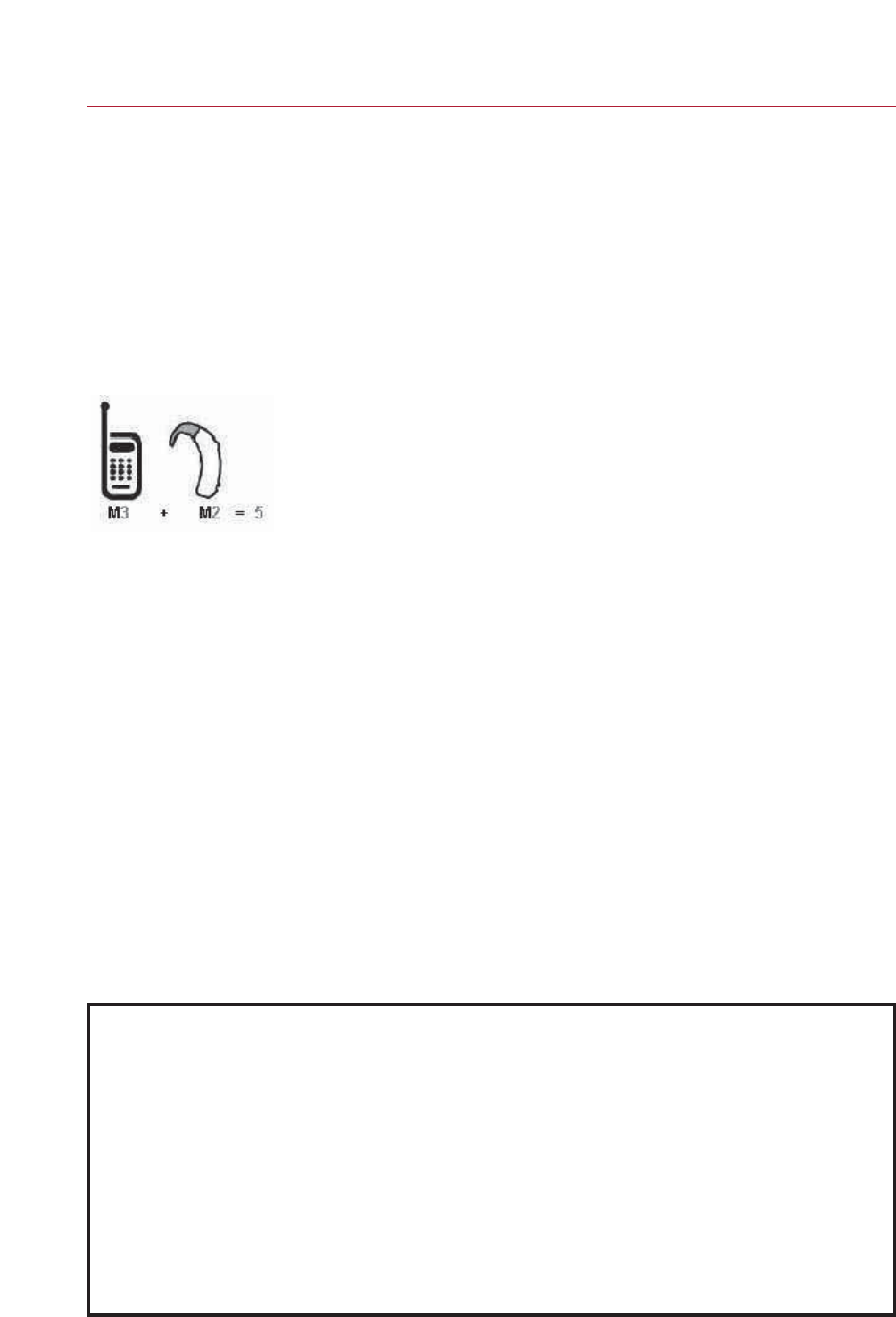
Hearing devices may also be rated. Your hearing device
manufacturer or hearing health professional may help you find this
rating. Higher ratings mean that the hearing device is relatively
immune to interference noise. The hearing aid and wireless phone
rating values are then added together. A sum of 5 is considered
acceptable for normal use. A sum of 6 is considered for best use.
In the example to the left, if a hearing aid meets
the M2 level rating and the wireless phone meets
the M3 level rating, the sum of the two values
equal M5. This should provide the hearing aid user
with “normal usage” while using their hearing aid
with the particular wireless phone. “Normal usage” in this context
is defined as a signal quality that’s acceptable for normal
operation.
The M mark is intended to be synonymous with the U mark. The T
mark is intended to be synonymous with the UT mark. The M and T
marks are recommended by the Alliance for Telecommunications
Industries Solutions (ATIS). The U and UT marks are referenced in
Section 20.19 of the FCC Rules. The HAC rating and measurement
procedure are described in the American National Standards
Institute (ANSI) C63.19 standard.
When you're talking on a cell phone, it's recommended that you
turn the BT (Bluetooth) mode off for HAC.
For information about hearing aids and digital wireless phones
Wireless Phones and Hearing Aid Accessibility
http://www.accesswireless.org/hearingaid/
FCC Hearing Aid Compatibility and Volume Control
http://www.fcc.gov/cgb/consumerfacts/hac_wireless.html

※ HAC statement
This phone has been tested and rated for use with
hearing aids for some of the wireless technologies
that it uses.
However, there may be some newer wireless
technologies used in this phone that have not been
tested yet for use with hearing aids.
It is important to try the different features of this phone
thoroughly and in different locations, using your hearing
aid or cochlear implant, to determine if you hear any
interfering noise.
Consult your service provider or the manufacturer of this
phone for information on hearing aid compatibility.
If you have questions about return or exchange policies,
consult your service provider or phone retailer.
.
.
.
.
※ Hearing Aid mode (T-coil mode)
If you select on, users using hearing aids with T-coil will
have better quality of sound. This T-coil mode will remain
on during the voice call.